#Accessibility visual elements review
Explore tagged Tumblr posts
Text

Accessibility is not a privilege but a right remarked Tim Berners-Lee, the inventor of the World Wide Web. Do You Love Our Reads Then Click Here:https://rb.gy/iej903 Click Here To Visit:https://rb.gy/uoyxqq
#Accessible Minds Tech#Accessible Minds#accessibility experts#Accessibility Solutions#Accessibility Evaluation#Accessibility Evaluation Services#Accessibility Evaluation Experts#accessibility component#fixing accessibility component#Recommendations for fixing accessibility component#Accessibility component recommendations#Drafting Voluntary Product Accessibility Template#Drafting VPAT services#VPAT’s developing services#Accessibility Design Review#Design Review for Accessibility#Accessibility visual elements review#Website Accessibility Remediation#Accessibility remediation and fixing services#Website Remediation and Fixing Services#Document Accessibility Services#Document testing and remediation#Document accessibility testing and remediation#Web Accessibility Development Services#Web Accessibility services#Web Accessibility Development experts#Digital Accessibility Testing Services#Accessibility Testing Services#Digital accessibility services
1 note
·
View note
Text
CREATING AUTHENTIC DEAF AND HARD OF HEARING CHARACTERS: A WRITER'S JOURNAL
Introduction
Creating authentic characters in your writing is essential for engaging storytelling, and this includes characters who are deaf or hard of hearing. To craft a character that accurately represents this community, it's crucial to do your research, gain a deep understanding of their experiences, and portray them with sensitivity and respect. In this journal, we'll explore how to write a deaf or hard-of-hearing character, including key information and preparation steps.
Understanding Deaf and Hard-of-Hearing Characters
Research: Start by researching deaf and hard-of-hearing individuals' experiences, challenges, and culture. Read books, articles, and personal stories, and watch documentaries or interviews featuring members of the Deaf community.
Consult with Experts: Reach out to members of the Deaf community or experts in Deaf studies to gain insights into their experiences. They can provide invaluable guidance and help you avoid common misconceptions.
Diversity Within the Community: Understand that the Deaf and hard-of-hearing communities are diverse. Some individuals communicate using sign language, while others rely on lip-reading, cochlear implants, or hearing aids. Be aware of these differences when creating your character.
Character Development
Backstory and Identity: Consider your character's background. Were they born deaf, or did they become deaf later in life? How do they identify within the Deaf community? Understanding their identity and experiences will shape their character.
Language and Communication: Decide how your character communicates. Are they fluent in sign language, or do they primarily rely on lip-reading and spoken language? Their communication style will influence their interactions with other characters.
Cultural Awareness: Explore the cultural aspects of the Deaf community. Understand the importance of Deaf culture, including its history, art, and values. Incorporate these elements into your character's life when relevant.
Writing Tips
Dialogue and Communication: When writing dialogue for a deaf or hard-of-hearing character, be mindful of their unique communication style. Use visual cues, body language, and facial expressions to convey emotions and context.
Access to Information: Consider the challenges your character may face in accessing information. This could involve issues with closed captioning, subtitles, or accommodations in educational or work settings.
Social Interactions: Depict social interactions realistically. Show how your character navigates conversations, group dynamics, and social events within their community and with hearing individuals.
Preparation
Sensitivity Readers: Consider hiring sensitivity readers who are part of the Deaf or hard-of-hearing community to review your work and provide feedback. Their insights can help you avoid stereotypes and inaccuracies.
Learn Sign Language: If your character uses sign language, take the time to learn at least basic signs. This will not only enrich your writing but also demonstrate your commitment to accuracy.
Beta Readers: Seek feedback from a diverse group of beta readers who can assess the authenticity of your character and offer constructive criticism.
Engage with the Community: Attend Deaf community events, workshops, or online forums to immerse yourself in the culture and better understand the perspectives and experiences of deaf and hard-of-hearing individuals.
Creating a deaf or hard-of-hearing character that resonates with readers requires dedication, empathy, and thorough research. By following these steps and embracing the rich culture and diversity of the Deaf community, you can create a character that is not only authentic but also promotes understanding and inclusivity in your writing. In addition, when writing dialogue for your deaf or hard-of-hearing character, remember:
It's important to clarify why, when writing dialogue for a deaf character, you should continue to use structured English grammar and not sign language structured grammar.
Maintaining Structured English Grammar:
Readability: Writing in structured English grammar ensures that the text remains accessible and comprehensible to all readers, including those who may not be familiar with sign language or Deaf culture. It avoids potential confusion that could arise from using sign language grammar in written text.
Universal Understanding: English is a global language, and adhering to its grammar rules allows for a wider audience to understand and engage with your story. Sign language grammar varies between different sign languages, making it less universally applicable in written form.
Respect for the Medium: While sign language is a rich and expressive mode of communication, it is primarily a visual and gestural language. Attempting to replicate sign language grammar in written text can be cumbersome and may not fully capture the nuances of sign language communication.
Balance of Realism and Readability: Striking a balance between authenticity and readability is crucial in storytelling. Maintaining structured English grammar while depicting a deaf character's interactions helps convey the character's experience without compromising the reader's ability to follow the narrative.
As an illustration, consider the following text: Dialogues with Descriptive Sign Language:
Sarah greeted John with a warm smile, her hands moving gracefully as she signed, "Hi, how are you?"
John returned the greeting in sign language, his expressions mirroring his words. "I'm good, thanks. Did you see the new movie?"
Sarah's eyes lit up as she signed back enthusiastically, "Yes, I loved it!"
In summary, using structured English grammar when writing dialogue for a deaf character is a practical and respectful choice that ensures your writing remains inclusive and accessible to a broad audience while still authentically representing the character's identity and experiences.
Furthermore, it's essential to avoid creating a character who is overly perfect or one-dimensional. In real life, we understand that everyone has imperfections and complexities, regardless of whether they are deaf or hard of hearing. Therefore, it's entirely acceptable to depict your character as a villain with a hearing issue if that aligns with your storytelling goals.
#writing deaf characters#hard of hearing#writing tips#writing resources#sign language#bsl#asl#auslan#fiction writing#building a character#writing guilde#writing characters with disibilities
1K notes
·
View notes
Text
Analyzing some of the very first BL visual novels
This is a bit of a recap of what I talked about during my Citrus con panel on Augustus 24th, so for those who missed it or who wanted a list of all the visual novels mentioned during the panel, you can find most of the information in this blog post! Japanese BL visual novels have been something I’ve been interested in since 2010-2011, and even these days many people in English speaking fanbases are familiar with games like DRAMAtical Murder and the other Nitro Chiral titles. I've played many older titles which I've previously reviewed on this blog, and in this post I will be looking at some of the very first BL visual novels and how the industry has changed throughout the years.

Before the very first "official" BL visual novels were released, some visual novels already existed in which a male protagonist had romantic or sexual scenes together with one of the other male characters. Some examples of this are games like Sotsugyou Ryokou (1996) and Ko-Ko-Ro (1998). Most of the other love interests in these games were girls, so they were not promoted as “boys’ love” games.
The oldest visual novel I could find that was promoted as a game which focuses on love between boys, is a game called Sei Valentine Gakuen, released by a company called B.M. in early 1999. This is a game in which you can name the protagonist, and none of the characters are voiced. While checking their old website through Waybackmachine, it seemed like the game had a lot of game-breaking bugs which they attempted to patch out, however the website quickly shut down within what seems like only a year (or maybe a few years) after its release date. Since there's not a lot of information about this game available online, I was surprised that someone bought the game second-hand and made a youtube video about it, so I recommend checking that out! You can watch it here. Despite being promoted as a game that focuses on love between boys it seems like there’s not really romance in the game, so I am curious why they marketed the game in this way.

Next is a game called BOYxBOY, released a few months after Sei Valentine Gakuen in April 1999. This is one of the games I actually got to play myself, and I was surprised to see this game was released by King Records (the record label) as I didn’t know they used to publish games, let alone BL games. The protagonist has a face and a name this time, but even though all the other characters are voiced, they decided to leave the main character unvoiced for some reason. This game does have romance elements, like confession scenes, but it's still quite minimal. There’s only one character who actually gets a kiss scene for example. This game did get a fandisc a year later, but it seems to be more of a collection of extra materials and minigames rather than something that really adds something to the story of the game.
Another BL visual novel that was released around this time in July 1999 is a game called Graduation (or Sotsugyou) by Joinac, which as the title suggests, focuses on the protagonist spending time with people at his school right before his graduation. This one actually got translated, so it's probably the first BL visual novel to ever get an (official) English translation. Unlike most other games from this time, this one can still be easily accessed too, as a digital version is available for purchase on DLsite.
Entering the 2000s, game developer AliceSoft created their own BL game brand called AliceBlue and released their first BL game called Kakurezuki in 2000. Even though AliceSoft released 18+ rated titles in the past, this first BL title was actually also all-ages. Some reviews mentioned that they don’t really consider the game BL at all, pointing out the lack of romance, and I can definitely see where they’re coming from. Pretty much all the other games I mentioned so far take place in a modern-day school setting, however this game is more of a historical fantasy game (although the plot still only focuses on the protagonist and his daily interactions with those around him).
A lot of the games during this time period still highly resembled the typical dating sim-style game, which was quite popular in the mid/late 1990s. This kind of gameplay means that usually, the player decides what the character is going to do that day, for example, what subjects he takes in school, which club he joins and which locations he visits. In games like Kakurezuki, it’s a bit different you decide what magic skills you want to strengthen that day. This kind of gameplay kind of limits what kind of story the writers can explore, as the plot mostly focuses on the main character’s everyday life and their interactions with other characters, and eventually also became something that’s not commonly used in BL visual novels anymore.

Later that year, in August 2000, one of the most well-known early BL visual novels was released. This was Sukisho (short for Suki na Mono wa Suki Dakara Shouganai) by Platinum Label. The company promoted this game as the “first 18+ boys love game” though Graduation also seems to be rated 18+ on DLsite. Sukisho gained a big fanbase, as many fans really liked the art (drawn by Tsutae Yuzu) and the characters. Even though the plot still focused on boys going to school, some characters do have a darker backstory. The company even created official forums where fans could discuss the plot of the game and fan theories. Some other boards also encouraged fan meetups at local conventions in Japan. It ended up getting 3 different sequels, a PlayStation 2 port, an anime adaptation, and various drama CDs and novels. These days a lot of BL visual novels get drama CDs, but back then this game really got a lot of extra content compared to other games. Like many others, I personally discovered this game through the anime many years ago, but I played the visual novel later as it has also been fan translated and was quite accessible back then.

Another visual novel that stood out, and which also got an anime adaptation, is Angel's Feather (2003). Unlike the rather confusing anime plot, which adds a new character that isn’t in the game, I think the plot of the visual novel is actually much better. Initially it does seem like another game about high school boys, but in reality it’s more of an RPG game that focuses on the characters learning more about the world they’re living in, and their own magic abilities. I think just like Sukisho’s artstyle, compared to many other games that were released at the time, the art of this game quite unique. The artist is Yamamoto Kazue, who worked on many visual novels, and is still active nowadays. This game also got a sequel and drama CDs, but sadly the third game they were working on was never released. The studio was also working on a completely new game called White Shadow, however this one also remains unreleased to this day. If you want to read a little bit more information about this game and other unreleased titles, I wrote a blog post about that too here!
The inclusion of RPG elements I briefly mentioned just now in visual novels was not something only Angel’s Feather did. For example, some of these other screenshots are from Ouji-sama Lv1, Teikoku Sensenki, and Apocripha/0. The gameplay varied from a simple battle system to complicated dungeons and hard to beat enemies, depending on the game. One downside of this is that it’s quite a time-consuming process if you want to see all kinds of different endings, as these parts of the game were usually unskippable. Gradually, this is also something that slowly became less common in BL visual novels.

Generally, a lot of older games were quite difficult to replay as most games only had a limited number of save slots, and sometimes there would be no preview images next to the save files either, so it was quite difficult to remember which save file you were supposed to load. Some of the oldest BL visual novels also don’t have a skip button, which means you have to play through all of the dialogue again if you want to see a different ending. The pictures below are my screenshots from Angel's Feather and Kannagi no Tori, a game that was released in 2001. Luckily both of these games do have a skip button, but there were never enough save slots!

Other than changes in gameplay and artstyles, something that has also changed quite a lot are the dynamics between characters in adult scenes. In most BL visual novels, the protagonist is either a top or a bottom, and this doesn’t really change throughout the whole game. For example, if the official website mentions that the protag is a bottom, that means he’s a bottom with every single one of the love interests. Something I noticed while playing older games is that this order wasn’t always fixed. In games like Laughter Land and Kannagi no Tori for example, the game would often let the player decide. A game that was released a bit later which also has this option is PIL/SLASH’s game Shingakkou -Noli me tangere. In every route, no matter what character, you make the decision. I think it’s kind of fun when the game gives you choices like this, although I’m not sure if they will ever bring it back.
Terminology and target audience When I talk about these games I use “BL game” and “BL visual novel” as these are easily understood when communicating with an English-speaking audience. However in Japanese these games are usually only called “BL game” or "AVG" which just stands for adventure game. In the early 2000s some official websites would refer to these BL visual novels as ''boys games'' to distinguish them from a genre called “girl’s games” or galge, which are games that would typically be for a male audience. Even though the term “yaoi” was becoming less common, some developers would also call them “yaoi games” on their website, as you can see in some of the screenshots below . It’s not like the term “visual novel” is something completely unknown to them, but it’s also not a term I ever see them using to promote their games.
As for the target audience, similar to a lot of BL manga, the target audience for many of these BL visual novels was also women. A lot of websites stated that these were games “made by girls for girls”. However, it’s better to not generalize the whole genre as something exclusively targeted towards women, as some games like Hotaru (released by Tarutaru in December 2000) and its sequels were specifically advertised as games "made by gay men for gay men". One of the games I mentioned earlier, Graduation, was also made by a doujin group that calls themselves the Gay Artist Support, and like the name suggests, they support gay artists and alleys. Therefore it can be concluded that even during this time period, it wasn't just women creating and reading BL.

Marketing and sales Some might be wondering; how did people discover these games back then? Around the year 2001, multiple websites were created by fans that kept track of new BL game developers, as well as any updates provided by the companies that were already established back then. A lot of these websites also gave fans the option to chat with each other in their forums. Some examples of these websites are BOY'S STREET and Boyslove Kenkyuujo (which translates to BoysLove research institute). They kept track of both commercial and doujin game releases. Companies and doujin creators would both sell their games at events like Comiket, Super Comic City and J-Garden too, where they would promote their games and chat with fans. Their games would also be sold at stores like Animate and Toranoana, which is not too different than how creators sell their BL games nowadays, as both of these stores still exist. A lot of BL game creators in the early 2000s were quite close to each other and collaborated. For example, some doujin groups like Anubis Label, Ritz, Moon Parrot and more created their own magazine called B-GAME, which featured information about their new doujin games, corporate games, survey results, game reviews and more. The picture below (on the right) is a picture I found on the website of doujin group Moon Parrot, promoting and selling their game Kuro no Tsuki at Super Comic City. Of course official BL game magazines also existed, but I think I will make a separate blog post about that (update: you can read it here!).

Well-known developers throughout the years Next I made a list of some BL game creators that established their brands in the early or mid 2000s, and who continue to be active nowadays. I will mention some newer games as well. There's way too many BL visual novels to include all of them, so I apologize if I missed some that were quite influential!

Langmaor/Tennenouji: The first game Langmaor released was a game called Enzai in 2002, illustrated by Yura. This game focuses on a boy whose name is Guys, who gets sent to prison as a result of a false accusation. In one interview, Yura mentioned that she was almost afraid that the plot of the game would be “too dark”, as the main character experiences a lot of abuse, but she concluded that at least the game would be unique. In 2004 Langmaor released Teikoku Sensenki, and a year later they released Zettai Fukujuu Meirei (or more well-known as Absolute Obedience). This game had a kind of unique system which focused on not one, but two protagonists. The final game this brand released was a game called Laughter Land (2006. The illustrations of this game were drawn by Yuzuki Ichi who had previously worked on Kannagi no Tori. Yura was also part of doujin group called Tennenouj, which already released their first BL game in 2000 called Sei Crain Gakuen, a BL game that you could play by opening HTML files in your browser. They released their second BL game in 2006, which was Miracle No-ton, a game about a notebook that could grand the protagonist’s wishes (horny wishes only though!). In 2009, Luckydog1 was released, which ended up becoming one of the most popular and well-known games in Japanese speaking BL visual novel fanbases. The game is about the protagonist Giancarlo, who’s a low-ranking member of the mafia and currently in prison, who receives the task to free 4 important members of the mafia from prison. Some BL gamemagazines like Cool-B have an annual popularity poll, and for years, LuckyDog 1 and its characters ended up in first place. On BL information websites like ChilChil it continues to be the highest rated BL visual novel to this day. Two years ago, Tennenouji also released the game Friendly Lab, of which the mobile version is still being updated, so even nowadays they are still very active.

Nitro + CHiRAL: Or just called “NITRO CHiRal” these days. They released their first game, Togainu no Chi, in 2005. In the early interviews the director stated that they wanted to create something different, as a lot of visual novels around this time focused on schoolboys and modern-day settings. So instead, they wrote a story that takes place in a futuristic version of Japan, devastated by a Third World War. Only a year later in 2006, they released their second game, Lamento -BEYOND THE VOID- which also takes place in a fictional world. Even though the characters look similar to humans, they call themselves Ribika and have cat-like characteristics. The characters in this game are struggling to survive, as a mysterious force called “The Void” is slowly destroying their world. Because of their unique stories and beautiful illustrations, Nitro Chiral quickly gained a big fanbase in Japan too. In some articles published in Cool-B magazine, they mentioned that they were taking even bigger risks with their next game, as the plot would be anything but happy. This was about their third game, sweet pool. Despite that, I think fans already expected dark and serious stories from the company, so it was still well-received. Before releasing DRAMAtical Murder, they released two more visual novels called Itsuwari no Alkanet and World’s end Nightmare, though these were only available on Chiral Mobile, an app that could only be downloaded on certain Japanese phones. These days these games are considered lost media, but I wrote a blog post about what I could find about them some years ago. Afterwards they released their more well-known games DRAMAtical Murder in 2012 and Slow Damage in 2021.

Pil/Slash: This is a BL visual novel developer that is well known for writing dark stories, with themes like abuse, noncon, physical and emotional torture. Though of course this is not too uncommon in BL visual novels, as all of the developers I’ve previously mentioned include themes like that in their games too.Their first game, Masquerade ~Jigoku Gakuen SO/DO/MU~, was released in 2006, followed by Koibito Yuugi a year later. In 2011, one of their most well-known titles, Shingakkou –Noli me tangere- was released. This game is about protagonist Michael who’s enrolled in a seminary. However, his school life is anything but peaceful, as his family gets murdered and he also discovers a secret society of devil worshippers in his very own school. At the moment this is the second highest rated BL game on ChilChil, after Luckydog1. After this they released Pigeon Blood in 2014, which was also a horror-themed game, and Paradise a few years later, which was quite popular in Japan too. In 2021 they released their newest game, Dystopia no Ou. This game focuses on protagonist Kiriku who dreams about becoming a rock star. Initially, this seems quite different than PIL/SLASH's previous games, but I promise the story still gets pretty dark. The writer credited for Paradise and Dystopia no Ou is Kyuuyouzawa Lychee, who's also the creator of doujin game group LOVE&DESTROY and games like CAGE OPEN and CAGE CLOSE.

Spray: This company’s first game was Saikyou Darling, released in 2001, but I think they are probably more well-known for their Gakuen Heaven series. The first Gakuen Heaven game was released in 2002, but since then they have released a few newer versions of the game, console versions and a second game. This is another one of these games that people might know because it has an anime and manga series. Spray has released quite a few different games like Soshite Bokura Wa, Piyotan, STEAL! and more recently Tsumi naru Rasen no Ori, but I think other than Gakuen Heaven their most well-known title is probably Kichiku Megane, released in 2007. This game focuses on protagonist Katsuya, a salesman who seems to be failing at everything in life. Just before he’s fired from his job, he receives a mysterious pair of glasses from someone. Whenever he wears these glasses, his personality completely changes. He suddenly becomes very skilled at everything, but also very sadistic. In recent years fans have started organizing fan events for this game at local conventions again, so it’s interesting to see how popular it still is.

Holicworks: Also known as LoveDelivery, as that’s the name they used to release some of their very first games, like Tsukigami (2007) and Beniiro Tenjou Ayakashi (2008). Their most well-known title Taisho Mebiusline, released in 2012. This game is a historical fantasy game which takes place during the end of the Taisho period, in 1923. The protagonist, Kyouichirou, moves to Tokyo in order to go to university. However, he runs into trouble soon after his arrival, as the Imperial Military becomes interested in his ability to see spirits. The writer of this game, Nakajo Rosa, is often praised for the historical research she did in order to write this game. The story covers all kinds of political issues, international affairs and military activity, and combines it with religious themes such as Shintoism. This also means that even for Japanese speakers, the game can be a bit difficult to read, as it tends to use difficult words and kanji. However, I think with a bit of research it’s not impossible. They also released games like Tokyo Onmyouji, Tokyo 24ku, and more recently Tokyo Satsujinki Gakkou no Kaidan, though the only game that has an English translation is Tokyo Onmyouji, which takes place in a more modern-day setting, but still focuses on supernatural themes like ghosts and spirits.

Karin Entertainment: Another developer that has been around for a long time, who released their first BL game series called Bois in 2002. Afterwards in 2004, they released the game Animamundi Owarinaki Yami no Butou~ (Animamundi: Dark Alchemist), which I’m not sure if I should be calling BL game as there are also a few female love interests. The games they released after this aren’t BL games, but instead they created a new branch called Karin Chatnoir Omega, which released the game Omertà ~Chinmoku no Okite~ in 2011. In this game the mafia controls the government, and the protagonist J.J. is a hitman who’s taking all kinds of assassination jobs. In 2016 they also released the game Omega Vampire, which is the first omegaverse BL visual novel.

Parade: This is a game developer known for creating games in which the protagonist is exclusively a top, or seme, which is also something that was not super common in the past. In a lot of other games almost all of the love interests are younger guys, so I think it was interesting to see at least two of the other main characters in NO THANK YOU!!! were over the age of 35. Even though most Parade games have a lot of 18+ content, like NO THANK YOU!!! and their second game Room No. 9, one should not underestimate the plot, as the writing is really good. My favorite game is probably their latest game, which is Lkyt., a historical fantasy game and my personal favorite.

CORE: This is the BL branch of a company called Orbit, and their most well-known game is Messiah, which was released in 2006. Though their first game was a game called Ever Loyalty in 2001, followed by Fanatica in 2004. Most of CORE's games only have 1 or 2 characters the protagonist can end up together with, although sometimes other characters in the game also have their own bad endings. In Fanatica, the protagonist only has one true love interest, but a lot of the other main characters are also paired up with each other, so even if they don't have their own route, you do get to see different scenes with them. Even though CORE released their last game in 2008, which is the Messiah fandisc Messiah ~ Paranoia Paradox. It was announced that they are actually working on a new BL project called Tokyo Gentou/Tokyo Phantasmagoria, under the new name Procyon.

Adelta: Not really 2000s as their first game was released quite some time later, but I think still important because they've gotten quite popular in recent years. This is a doujin game group created by Kurosawa Rinko. The first games this group worked on were Cocoon and Cocoon Black Noise, released in 2014. The game they’re probably most known for is Koshotengai no Hashihime (Hashihime of the old Book Town). This game is quite well known for its references to literature and real writers, and the story also takes place during the Taisho period. Originally it was advertised as a time-loop murder mystery. In 2020 Uuultra C was released, which is a completely different kind of game that takes place during the Showa period and focuses on heroes you’d typically see in a Super Sentai Series, or Tokusatsu movies in which the characters fight kaiju. Adelta is currently working on their newest game, Ooe.
Conclusion Of course there are many more BL visual novels which left a big impact on people, even less serious games like Gakuen Handsome which still get referenced a lot to this day. Another well-known title is Mada Koubou's Hadaka Shitsuji, which was mostly created by artist and writer Togo Mito. It kind of difficult to determine how many BL visual novels currently exist, but BL information website ChilChil currently lists 345 titles in this database. This does however include fandiscs and games that aren't technically BL games, and also doesn't include all doujin games ever released.
The early 2000s was a good time for BL visual novel fans and a lot of developers were making BL games back then, which also meant that there would be many new games to play. These days the number of active developers has significantly decreased, so most of the time you get about 1 or 2 big releases every year. Of course, there are still doujin groups and individual creators who make their own games, but the number of commercial releases is pretty small nowadays.
Some games that were released earlier this year however, are Tokyo Satsujinki Gakkou no Kaidan and Haiiro no Arcadia. I am personally also looking forward to the release of Adelta's new game Ooe, and Procyon's Tokyo Gentou/Tokyo Phantasmagoria, so I recommend checking those out when they're released!

235 notes
·
View notes
Text

Dragon Age™: The Veilguard - Accessibility Resources - (Accessibility Portal information)
"In Dragon Age: The Veilguard, players are encouraged to be who they want to be and play how they want to play. This manifests in all sorts of ways, from our character classes to the dialogue choices. But delivering on this promise requires more than providing a variety of gameplay options; it also requires us to break down any barriers our players may be experiencing. For that reason, we incorporated accessibility considerations into our design documentation from very early in the game’s development, making the thoughtful and deliberate implementation of accessibility a foundational component of The Veilguard’s design. On first launch, players are provided a curated list of settings for UI text size options, subtitle options, controller options, and various display options. Upon starting a new game, players can use our Customizable Difficulty system to choose the level of challenge they want to experience. By selecting from a list of modular combat presets, they’ll be able to individually adjust a number of granular factors, including enemy aggression, enemy resistances, and combat timing. Similarly, our exploration presets allow players to modify on-screen guidance, such as markings that assist with way-finding and the distance at which interactable objects become highlighted. While we’re particularly proud of and excited about Customizable Difficulty, we encourage players to browse through all the settings and review the accessible design considerations outlined in this guide. And as always, accessibility is a continuous journey and we are actively listening to feedback from the community. Thank you."
"Noteworthy Features - Visual - Audio - Controls - Gameplay"
(The rest of this post is under a cut due to length.)
"VISUAL Subtitles - Subtitles can be set to Never, Conversations Only (excludes ambient NPC dialogue), or Always (all audible dialogue). By design, captions are embedded into subtitles to convey non-verbal sounds that progress the story or add additional context to some story beats and spoken words. - Advanced Subtitles Options are available, where size can be adjusted between three options, speaker names can be turned On/Off, background opacity can be scaled from 0% to 100%, and name colors can be adjusted for Rook and NPCs."

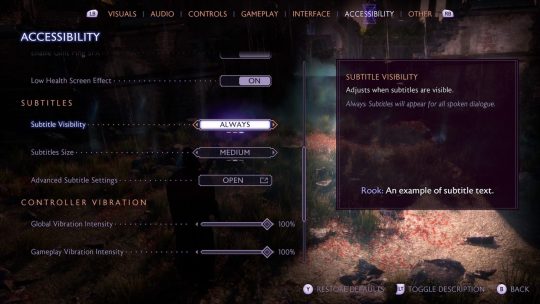
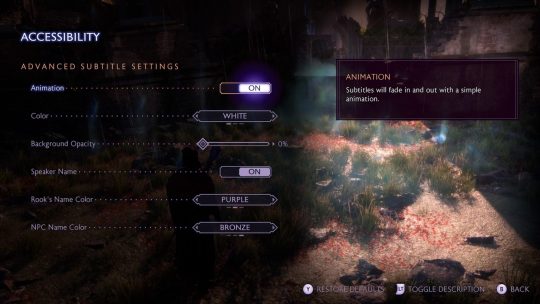
"User Interface - UI Text has two size options and uses a simple font. - Full-screen Colorblind filters are available for Protanopia, Deuteranopia, and Tritanopia. - Persistent Dot is available to display a small dot at the center of the screen. - Hiding HUD Elements is available for the Objective Tracker, Mini Map, Combat Text, Advanced Combat Text, Player Health, and Abilities."
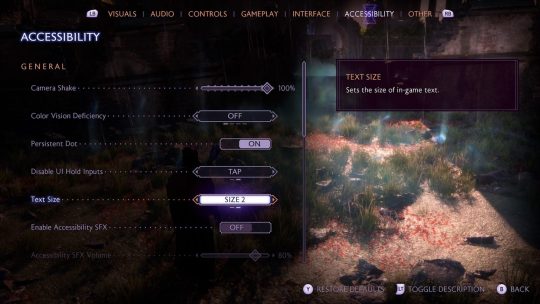
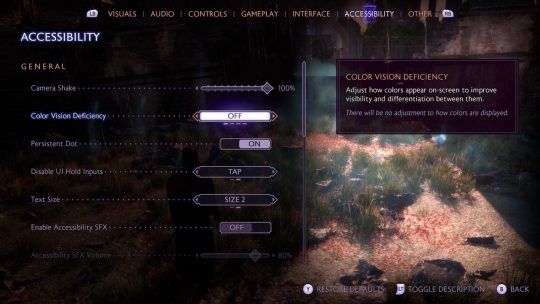
"Visual Design & Assists - Melee Threat Indicator provides a halo around the player character’s head to warn of incoming melee attacks. - Ranged Threat Indicator provides a visual line to show the direction of incoming ranged attacks. - Visual cues are present during combat and exploration, where no game-critical information needed to progress is conveyed through sound alone. See Customizable Exploration Presets for more."
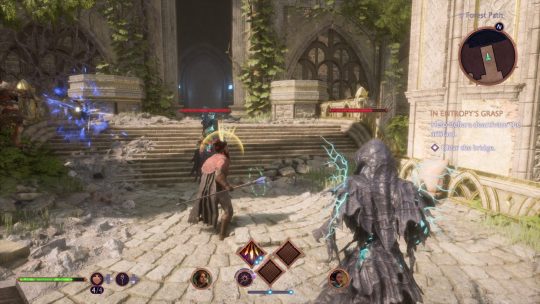
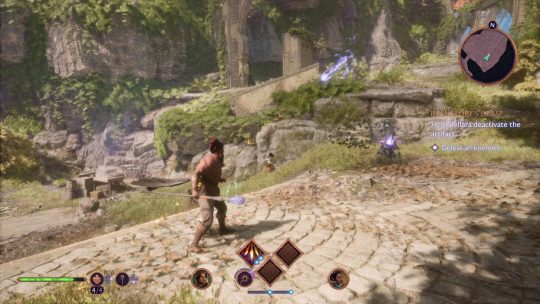
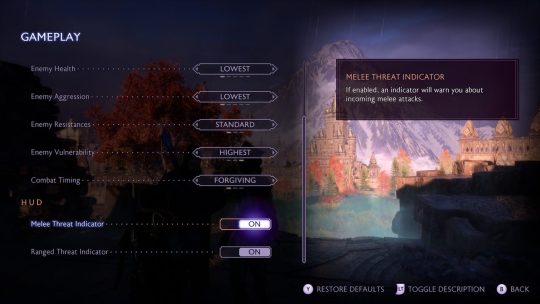
"Visual Effects - Motion Blur can be turned On/Off. - Camera Shake can be set between 0 (Off) and 100 (Max). Does not extend to cinematics. - Depth of Field can be set to On for cinematics only, On for gameplay only, On for both, or Off. Being On causes some elements of the scene to be in focus, and others to be out of focus. - Vignette can be turned On/Off. Being On creates a subtle darkening of the image towards the edge of the screen during cinematic and gameplay to enhance the atmosphere of scenes. - Low Health Screen Effect can be turned On/Off. Being On creates a blurry, desaturated effect across the screen during gameplay to emphasize low health."
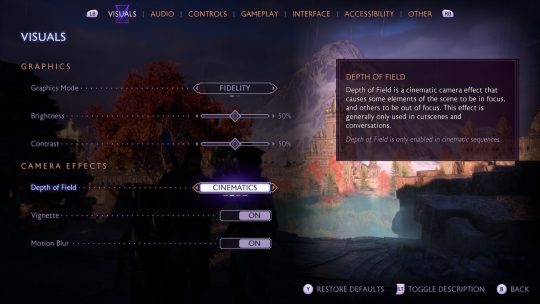
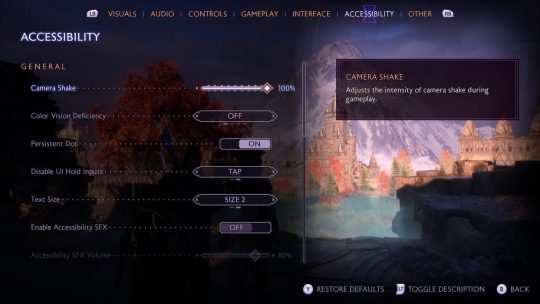
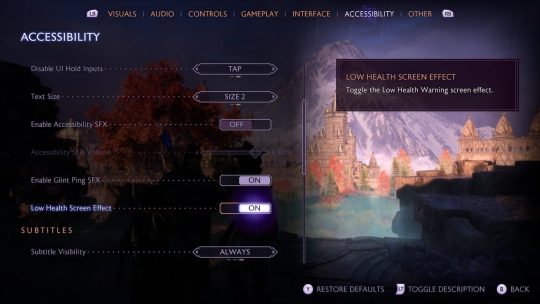
"AUDIO Audio Settings - Volume sliders for Global, Music, Speech, Sound Effects, Ambient, and Menu. - Speaker type for Wide Dynamic, Narrow Dynamic, Night Mode, and Headphones. - 3D Audio is available. Requires compatible hardware. - Mono Audio is available alongside a mono audio planning option between left and right outputs."
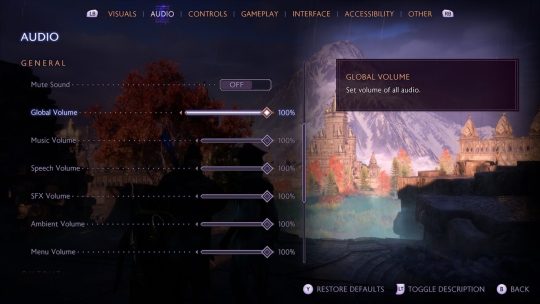
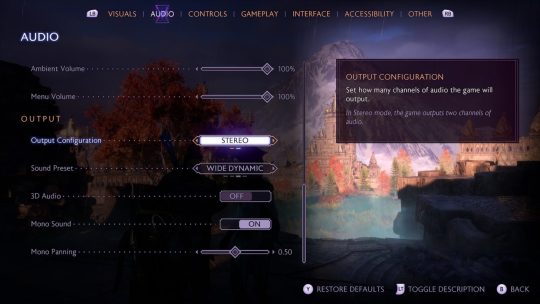
"Sound Design & Assists - Accessibility SFX is available and has a volume slider. Audio cues provide additional feedback for some visual mechanics. Includes an incoming attack indicator, target lock-on, and conversation wheels. - Glint Ping SFX is available where spatialized SFX will play at object locations when UP on the d-pad is pressed. Note: Depending on the Exploration Preset selected, players may need to adjust the Object Glint Visibility, and Object Marker Visibility settings to Pulse (Short), for this functionality to work."
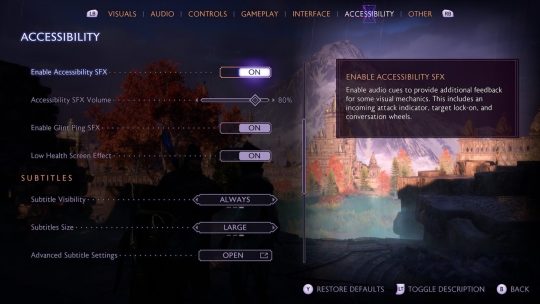
"CONTROLS Input Settings - Input Remapping for basic gameplay controls. Movement actions can only be remapped between analog sticks. - Invert Axis of X and Y can be individually adjusted for both controller and mouse. - Vertical and Horizontal Sensitivity sliders for both Cameras and Aiming. - Swap between Left and Right Sticks for Movement (left) and Look (right). - Stick Deadzones sliders for the Look and Movement sticks. - Trigger Deadzone slider for triggers on controllers. - Vibration Intensity slider for Global, Gameplay, Environment, and Cinematic."
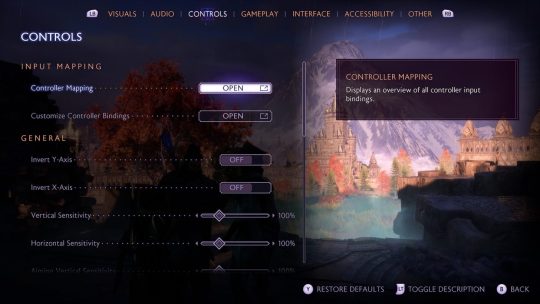

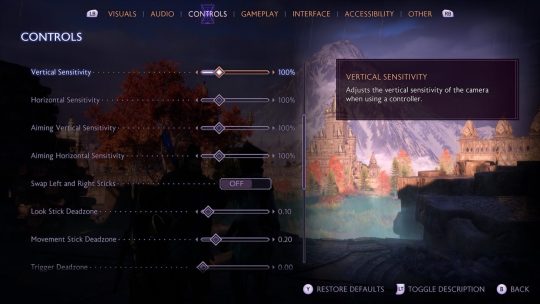
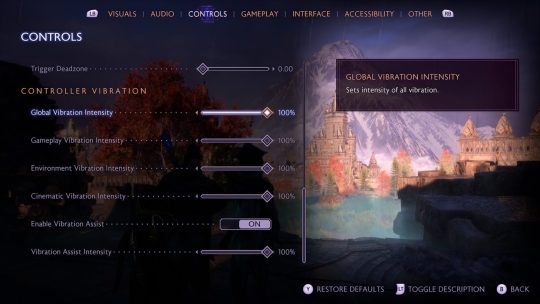
"Button Holds - Disable UI Hold Inputs can be set to Hold or Tap. When Tap is selected, various UI interactions that require an input be held for a set period of time can be activated with a single tap instead. Does not apply to gameplay actions. - Ability Wheel Controller Activation Type can be set to Hold or Tap. When set to Tap, the ability wheel will remain on screen without requiring any persistent input. - Blocking and Aiming require sustained holds. Aiming without holds is possible if the persistent dot is enabled, which can be used as an alternative to the aim-down-sights reticle."
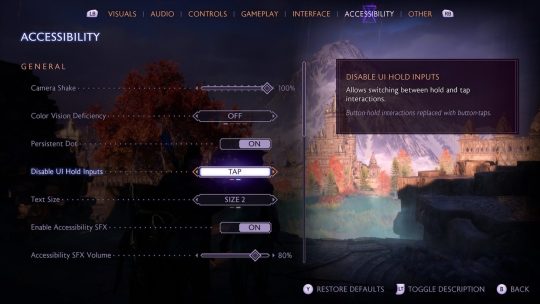

"Combat & Gameplay Controls - No QTES (quick time events) are present by design. - Rapid input sequences are present for certain attack combos during melee combat, if used. - Simultaneous inputs are present for ultimate ability, or if using the ability shortcut menu. - Quick and precise timing is not required for progression. Finisher moves, which are optional and hasten the end of combat, may require faster reactions. - Combat Assists are available in the Combat Presets to further simplify inputs during combat. Includes Aim Assist, Aim Snap, Combat Timing, and more."
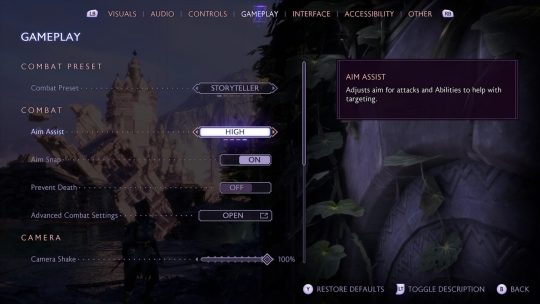
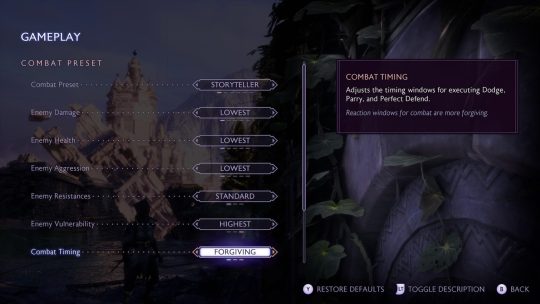
"GAMEPLAY Combat Customization Choose between presets of Storyteller, Keeper, Adventure, Underdog, Nightmare, or Custom: - Aim Assist can be set to Off, Low, Medium, and High. - Aim Snap can be turned On/Off to snap to targets. - Prevent Death can be turned On/Off. Available only in the Storyteller preset. - Enemy Damage has five options to adjust the strength of incoming attacks. - Enemy Health has five options to adjust the amount for enemy health. - Enemy Aggression has five options to adjust how aggressive enemies are during combat by changing how often they attack and how difficult they are to stagger. - Enemy Resistances has three options to adjust how much enemies can resist incoming damage. This will not affect the natural resistances some enemies have based on their faction though. - Enemy Vulnerability has three options to adjust how weak enemies are to incoming damage. This will not affect the natural weaknesses some enemies have based on their faction though. - Combat Timing has three options to adjust the timing windows for executing Dodge, Parry, and Perfect Defend actions."
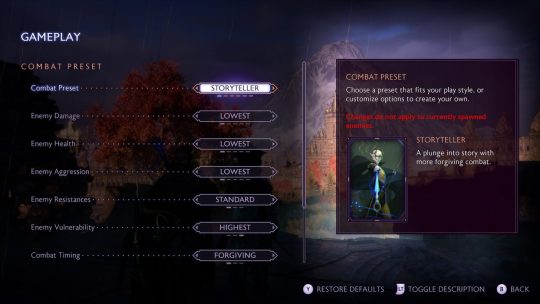
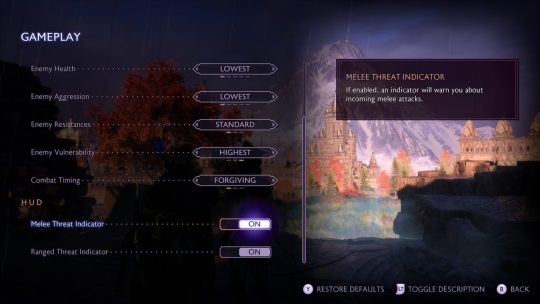
"Exploration Customization Choose between presets of No Assists, Pulse Only, Standard, Directed, or Custom: - Object Glint Visibility can be set to Off, Pulse (Short), Pulse (Long), Always to change the visibility of the glint highlight on interactable objects. - Object Glint Distance can be set to Close, Standard, and Far to change the distance of where glint highlights on interactive objects will appear. - Objective Marker Visibility can be set to Off, Pulse (Short), Pulse (Long), and Always to change the visibility of objective markers. - Waypoint Visibility can be turned On/Off to toggle the visibility of navigation waypoints leading to your quest objective."
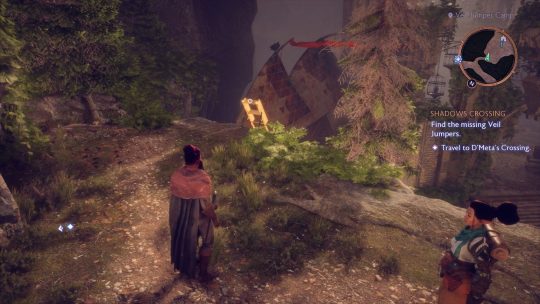
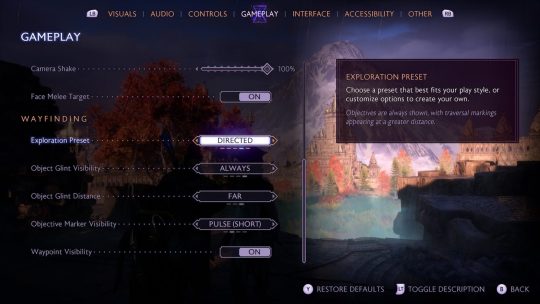
"Guidance & Progression - A Library is available for players to access at any point to help recall information. Here, players can browse the Codex to review stories and information discovered during progression, re-read letters from companions and others within the Missives, and reference the Glossary for explanations of terminology specific to Dragon Age Lore. - Tutorials teach gameplay mechanics as new inputs, skills, or actions surface. - World and Local Maps are available for wayfinding and can be referenced at any point. - Waypoint Visibility can be turned On/Off to help with progression. - Objective Marker Visibility can be adjusted between Off, Pulse (Short), Pulse (Long), and Always. - Pausable gameplay is available by design. - Saving is robust, where auto–save is frequent and players can manually save any time outside of combat, cinematics, and dialogue cutscenes."
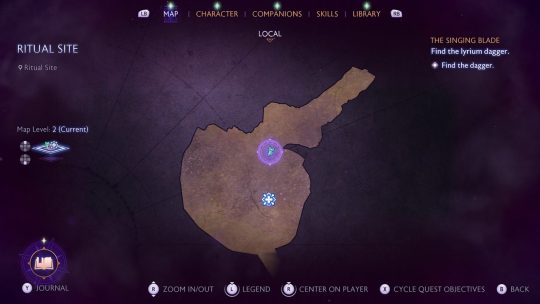
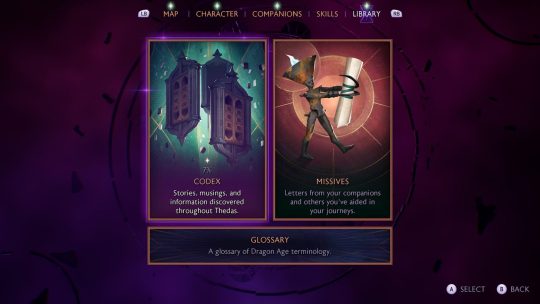
"Additional Information For more information about the game, patch notes, and news, visit the official website. Please note that this information is based on the US, English version for PC and consoles."
[source]
#dragon age: the veilguard#dragon age: the veilguard spoilers#dragon age: dreadwolf#dragon age 4#the dread wolf rises#da4#dragon age#bioware#video games#long post#longpost#solas
104 notes
·
View notes
Text
Web designer in Jodhpur
Creative Web Design
We are a web designing company that has a team of skilled and experienced web designers and developers who can create stunning and functional websites for any type of business or domain. We offer a variety of web designing services, such as custom web design, web development, web hosting, SEO, and maintenance. We also provide you with a free web design consultation, where we can discuss your goals, needs, and preferences, and provide you with a web design proposal that suits your requirements and expectations.
What we do in Web Design
Our web designing services are the services that provide web designing solutions for clients who want to create or improve their online presence. It involves the use of various elements such as colours, fonts, images, graphics, animations, and interactions to convey the message and purpose of the website to visitors. Web designing services can help clients with various aspects of web designing, such as Consultation: Our web designing services can help clients understand their goals, needs, and preferences, and provide them with expert advice and guidance on how to achieve them . Strategy: Our services can help clients develop a clear and effective web design strategy that aligns with their brand identity, target audience, and business objectives.Design: We help clients create a unique and attractive web design that reflects their vision and personality, and that engages and impresses their visitors.Launch: Our services can help clients launch their website to the public, and provide them with web hosting, domain registration, and security services.
Our Design Technology
At Web Farm House, we understand that web design is not just about making a website look good. It is also about making it work well, communicate effectively, and provide value to the users. That is why we use the latest web design technology to create websites that are:
Visually appealing: We use web graphic design to create stunning and consistent visual elements for your website, such as colours, fonts, images, icons, and animations.
Easy to use: We use user interface design to create intuitive and interactive elements for your website, such as buttons, menus, forms, and navigation.
Functional and reliable: We use web development to code and program your website, using languages such as HTML, CSS, JavaScript, PHP, and others. We follow the principles of web standards, web accessibility, web performance, and web security, to ensure the quality and reliability of your website.
Our Work Process
At Web Farm House, we follow a systematic and collaborative work process to create your website. Our work process consists of four main phases: Discovery, Design, Development, and Delivery:
Discovery: This is the phase where we get to know you and your project. We will ask you some questions about your goals, needs, preferences, budget, and timeline. We will also conduct some research on your industry, competitors, and target audience. Based on the information we gather, we will create a project proposal and a contract for you to review and approve.
Design: This is the phase where we create the visual and interactive elements of your website. We will start by creating a sitemap and a wireframe, which are the blueprints of your website’s structure and layout. We will then create a mockup, which is a prototype of your website’s appearance and functionality. We will present the mockup to you and ask for your feedback and approval. We will make any revisions as needed until you are satisfied with the design.
Development: This is the phase where we code and program your website. We will use the latest web development technology to create a website that is functional, reliable, and compatible with different devices and browsers. We will also test and debug your website to ensure its quality and performance. We will show you the progress of the development and ask for your feedback and approval.
Delivery: This is the final phase where we launch and maintain your website. We will upload your website to your chosen hosting service and domain name. We will also provide you with a user manual and a training session on how to use and update your website. We will also offer you ongoing support and maintenance services to keep your website running smoothly and securely.
We will also listen to your feedback and suggestions and make any changes as needed. We will work with you as a partner and a friend, not just as a client and a vendor. we value your input and satisfaction throughout the work process. We will communicate with you regularly and keep you updated on the status of your project.
Our Web Designing Services
Our is provides web design services for clients who want to create or improve their online presence. We help clients with various aspects of web designing, such as consultation, strategy, design, development, testing, launch, and maintenance:
Static web design
Liquid web design.
Adaptive web design.
Dynamic web design.
Responsive web design.
Single-page web design.
Why Choose Us?
We are a One-Stop Solution for delivering the best web design and development services. We render customized and affordable web design facilities to suit your requirements. Choose the best plans for building a responsive web design according to your needs:
Excellent technical support
Core PHP &Codeigniter + MySQL.
Secure and Reliable coding.
Satisfactory Customer Support.
SEO-friendly web development.
33 notes
·
View notes
Text
How many glitter balls do you need to stage a production of Shakespeare’s Much Ado About Nothing? The answer it seems, is four, or it is for a Jamie Lloyd production at least. How much pink confetti? Well, that’s a trick question; you can never have too much pink confetti.
Jamie Lloyd’s production of Much Ado About Nothing at the Theatre Royal Drury Lane is a vibrant reimagining of Shakespeare’s beloved comedy, even if it does stray from the original, and powered by electrifying performances from Tom Hiddleston and Hayley Atwell.
That blizzard of coloured paper pours down on the stage, with varying levels of intensity for the duration of the show. Falling on Soutra Gilmour’s non-existent set it succeeds in immersing the audience in a party-like atmosphere.
The production’s hot pink aesthetic feels both playful and contemporary, and brings something that was lacking in The Tempest. Though many of the cast return this is a more high-energy interpretation for Messina’s romantic entanglements.
With a soundtrack of Nineties bangers, Fabian Aloise’s movement direction ensures the stage brims with life, with dance and music interwoven into the narrative. Mason Alexander Park, as Margaret, provides the majority of the vocals, and just like in The Tempest, proves to be the highlight of the evening.
This dynamic approach breathes fresh energy into Shakespeare’s text while making it accessible to modern audiences. Though it should be said that not all of the cast are adept with the moves or vocals, and the cringe factor (possibly intentionally) is off the scale.
At the heart of this production are Hiddleston and Atwell as Benedick and Beatrice. Their chemistry is magnetic, delivering sharp-tongued banter with impeccable timing. Hiddleston’s Benedick is both charmingly cocky and self-deprecating, while Atwell’s Beatrice exudes wit and emotional depth. Their sparring scenes are a masterclass in comic timing, yet they also shine in moments of vulnerability as the characters confront their true feelings.
The supporting cast adds further depth to the production. Mara Huf’s Hero is delicately portrayed, while James Phoon’s Claudio captures both youthful passion and naivety.
Tim Steed’s Don John brings just enough menace to his scheming without overshadowing the comedic elements. Meanwhile, Mason Alexander Park as Margaret injects humor and warmth into the ensemble.
To accommodate all this partying, and a couple of scenes resembling an episode of The Masked Singer, this Much Ado About Nothing has seen cuts. Key emotional moments, especially in Claudio and Hero’s storyline, feel rushed, leaving less room for their arc to resonate fully. Additionally, while the modern aesthetic is striking, it occasionally risks overshadowing Shakespeare’s language. Some moments of dialogue feel slightly lost amid the visual spectacle.
The confetti storm briefly turns to a drizzle in the second act, as the darker elements of the story emerge. Here, Lloyd successfully balances humour with heartbreak, ensuring that the play keeps some of the intended emotion. Ben and Max Ringham’s sound design further enhances the production, underscoring pivotal moments with subtlety.
Jamie Lloyd’s Much Ado About Nothing is a daring and inventive production that showcases Shakespeare through a modern lens. It won’t be for everyone; it’s desire to be a party piece leaves some aspects under explored and diminishes the emotional impact of others. Still, it remains an exhilarating theatrical experience anchored by stellar performances from its leads and ensemble.
⭐️⭐️⭐️⭐️
27 notes
·
View notes
Text
Mod Role Descriptions
Since there has been some confusion! Thanks to @thatartiststudios for explaining this so well. (Note that all the dates on this could be subject to change.)
Fic Mod
Role Overview: The Fic Mod oversees all fanfiction contributions, ensuring high-quality. This role involves reviewing applications, providing feedback, and editing submissions.
Key Responsibilities:
Review writer applications, scoring portfolios (2-3 excerpts, 500-3000 words) for storytelling, Rayllum characterization, and Arc 2 relevance (August 2025).
Coordinate with 10-15 writers via Discord, managing check-ins (outlines, drafts, finals) from September to November 2025.
Edit fics for grammar, clarity, and consistency, ensuring they meet guidelines (SFW, 500-3000 words, G/T rating).
Collaborate with the Art Mod (Tategaminu) for artist-writer collabs (if applicable).
Assist with PDF layout by organizing fics thematically (December 2025).
Skills Needed:
Strong writing/editing skills (familiarity with Google Docs or Word).
Organizational skills to track deadlines and provide constructive feedback.
Discord communication for contributor support.
Time Commitment: 5-8 hours/week, peaking during application reviews (August) and editing (October–November).
Contributor Mod
Role Overview: The Contributor Mod manages the overall contributor experience, ensuring artists and writers stay on track and feel supported. This role is focused on coordinating deadlines and communication across the team.
Key Responsibilities:
Oversee contributor applications (August 2025), coordinating with Fic and Art Mods to select 20-30 contributors (10-15 artists, 10-15 writers).
Manage Discord server, posting announcements, reminders, and guidelines for contributors.
Track check-ins (September–November 2025), following up with contributors on sketches, drafts, and finals.
Handle dropouts (10-20% expected) by activating pinch-hitters from the backup list.
Resolve contributor questions or conflicts via Discord, maintaining a positive, inclusive environment.
Assist with final PDF compilation and charity donation logistics (February–March 2026).
Skills Needed:
Project management or organizational skills (e.g., Trello, Google Sheets).
Strong communication to liaise between mods and contributors.
Conflict resolution to handle delays or disputes calmly.
Time Commitment: 6-10 hours/week, peaking during application reviews (August) and check-ins (September–November).
Design/Graphics Mod
Role Overview: The Design/Graphics Mod creates the visual layout of the PDF zine, ensuring a polished, cohesive look that showcases art and fics. This role includes formatting the PDF and potentially designing the cover (if our potential cover artist is unavailable).
Key Responsibilities:
Format the PDF (December 2025) using Canva or Adobe InDesign, arranging 50-70 pages of art and fics by theme (themes to be announced).
Design or integrate the cover art, ensuring it reflects Rayllum’s Arc 2 vibe (November–December 2025).
Add elements like table of contents, contributor bios, and charity info, maintaining consistent fonts and margins.
Test the PDF for quality (300 DPI, compressed for download) and accessibility on multiple devices.
Collaborate with Fic and Art Mods to ensure submissions meet specs (A5 art, formatted fics).
Skills Needed:
Experience with graphic design tools (Canva, InDesign, or similar).
Eye for aesthetics to create a professional, fandom-inspired layout.
Basic understanding of PDF formatting (e.g., DPI, file compression).
Optional: Ability to create cover art if needed.
Time Commitment: 4-7 hours/week, peaking during PDF layout (December 2025).
15 notes
·
View notes
Note
I’d like to know what your thoughts are on the ramp to the entrance to Collège Françoise Dupont that was built between Seasons 2 and 3.
Remember, from “Heroes’ Day - Part 1”
ALYA: Last year, I wrote an article about equipping public buildings with disabled access. But after seeing Ladybug and Cat Noir going that extra mile every single day, I decided that I, too, can do better. So I got the mayor’s approval to improve facilties so that handicapped kids can actually attend our school.
The stairs from “Origins” to “Heroes’ Day - Part 2”
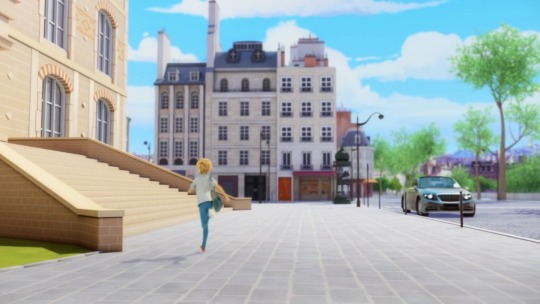
The stairs in “Chameleon” and onwards
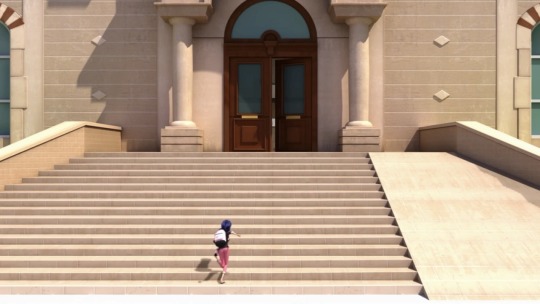
On paper, this is nice. A piece of worldbuilding on par with the akuma alerts like the one in “Riposte”.
However, there are three problems with this:
No one I’ve seen react to the show has noticed or remembered this, since the handicap accessibility is just a throwaway line from Alya that we don’t actually get to see being built.
We know how badly representation is presented in this show, so it’s not like this is getting any brownie points from me.
How the heck is a handicapped student supposed to get up a ramp that steep?
Collège Françoise Dupont's design is based off of Lycée Carnot, a real Parisian school, so I looked to see how the real school handled this issue. After looking at pictures of the school on Google, those steps seem to be a show-only addition. Which is interesting because the show tends to just copy the locations that inspired it. Now I'm wondering if those steps were inspired by something else?
Either way, it's hard to be too critical of the ramp's appearance without knowing the full story. While I fully agree that this is not a functional ramp, we do have to remember that there is a real-world cost associated with adding the ramp to the show. Someone has to design it and add it to the model, so I understand why they did it cheaply. Redesigning the steps into something more elegant and truly functional would have been ideal, but probably impossible to justify budget-wise since it's just a minor visual element. Same goes for animating someone putting in the ramp, which would be even more expensive. I'm honestly surprised that they added the ramp at all!
Now, does that mean that they should be praised for taking the time to put in a slap-dash ramp while never actually acknowledging or using it? No. To me, this feels like a lesser version of their choice to make Marinette a fashion designer while working in a medium that rarely allows her to design anything or even just change her outfit because, once again, budget! Before adding something to your script, you really should think through whether or not you can execute it properly. If you can't, then maybe pick a different path?
To be fair, it's possible that they didn't realize how bad the ramp would look until it was time to animate it. At that point, there's not really a great way to fix the problem. Do you leave the steps as-is even though you've explicitly drawn attention to the accessibility issue or do you be technically faithful to what you promised and put in a non-functional ramp? I don't know. I'm leaning toward "just don't add it," but neither choice is great.
It's even possible they may have only seen the ramp after it was too far in the animation process to revert back to the steps. With most or all of the animation being done out of house (I'm not actually clear on what if anything was done in house prior to season six), they almost certainly weren't seeing every step of the process or having daily reviews of what things were looking like, allowing for detailed input. How much input did they have? No idea! They absolutely got to review story boards or possibly even make them, but between the story board and the final 3D product? No idea.
I looked online for a general guide of the steps involved in working with an outside animation studio and this one generally matches what I know of the process if you want a high-level idea of how this can go and why redoing things may be no small request even if the models already exist. Once a scene is rendered, you have to completely rerender it to make any changes and that's pricey! Sometimes you just have to take a lesser quality product and go with it.
In summary, without knowing more details about what happened here, I don't feel fair being super critical of this, but it's certainly not getting any praise from me.
25 notes
·
View notes
Text
Games I Played in 2024
I played a lot of games this year (finished 33 but dropped a few others) and thought I'd write up some quick reviews. Didn't include Metaphor Refantazio since I only played the demo of that (really enjoyed it though), but I did include Hades 2 since I put in 100 hours into it and I think it's pretty obvious I like it lmao. listed in chronological order of when I played it
Howl: Hate to start out with a game I dropped, but I was just really bad at the puzzles in this one lol. You play as a deaf woman who is immune to the "howling plague" which turns people into feral beasts, so she alone travels the land to help villagers and try to find a solution. Really neat concept, I was just bad at the grid-like puzzle system.
Kena: Bridge of Spirits: 3/5 Thematically it's maybe a story more appropriate for children, in that you play as a young woman charged with taking care of spirits who have moved on and looking after the environment, but the combat was hard enough that it felt more suited for adults, which made me kind of wonder what the target audience really was. Visually it's stunning, and it's got all the elements of a typical AAA game these days (collectibles, puzzles, zones to explore). I found the plot a little simple, like if Disney wrote the game and Pixar animated it, but the gameplay could occasionally get hard. I've never played a soulslike game before so I can't comment on whether it is appropriately challenging for a "soulslike," like some have debated.
Persona 5 Tactica: 4.5/5 I enjoyed this one! The gameplay feels like Fire Emblem strategy set in the Persona world, which can be a bit simple in the main story maps but gets increasingly complicated in the challenge/side maps, especially those where you have to accomplish an objective in one turn. The chibi art style might turn people off but this feels very at home with the main game's story and themes with two surprisingly fun new companions.
Venba: 4.5/5 What a surprise I like the cooking game about a family adjusting to life and dealing with Asian diaspora. I think it could've been longer because I was enjoying the recipes but it did make me cry. Phenomenal soundtrack too.
Eastshade: 3/5 The idea is that you're a painter and you can walk around an island and capture the scenery on your canvas to fulfill requests from locals. Unfortunately it felt more like Crafting: The Game which wasn't really what I signed up for but it's still a relaxing time.
Dépanneur Nocturne: 3.5/5 A short little game I picked up randomly. You go shopping at a convenience store late at night and find some weird things on the shelves. Unexplainable, cute, kinda fun.
Hidden Through Time: 3.5/5 A cute little find-the-items game with the ability to make your own themed maps. There was a lot of variety in the levels.
Yoshi's Crafted World: 3/5 I played this at May's when I was catsitting at her house lol. Cute time-waster for a platformer I'd recommend for kids but honestly got a little grindy at the end.
Hades 2: (Personal GOTY) 5/5 Though it came out in May, I played this pretty much throughout the year. It is in Early Access, but I truly believe this game has more polish and content than most finished games have on release, so in my heart it counts. Melinoë is a wonderful character, there's some real depth, heart, and humor to the writing, and the world has gotten even grander and denser than in Hades 1. The stakes are high in that she has to defeat an undying Titan over and over again to save her family, but the game still feels quintessentially Hades while also reshaped to fit Mel's character and journey. I feel like the team knows exactly what they want and what they're doing. Supergiant doesn't miss and I'm very excited to see what future updates hold.
Synergia: Dropped. This is a cyberpunk visual novel with robot yuri about an overworked detective who purchases a new household android for company. I ended up putting it down because the writing was... mostly fine, but when it stumbled, it felt very awkward and unnatural; I also realized the main writer was a man, which made some of the "oops, I have to sleep naked" lines coming from the childlike android feel fetishy at times. It wasn't constant, but it was prevalent enough to bother me. Still I've seen some wlw enjoy it anyway or even embrace those aspects, so what I don't like someone else might.
Harmony: The Fall of Reverie: 3/5 This one has a neat concept. Polly, the main character, is tasked with keeping balance between two worlds while juggling the desires of Glory, Bliss, Power, Chaos, Bond, and Truth, who are anthropomorphized characters you can agree or disagree with in their direction to lead humanity. The gameplay idea is that you can see the consequences of your choices branching out before you make them, which at times is really cool because it lets you plan what you want, but at times also feels like you're really just looking at the behind-the-scenes of the developer code lol.
Hello Goodboy: 2.5/5 I must've misjudged this one because I think it was either for real little kids, or it just wasn't translated well. It's a story about a kid and his dog in the afterlife. Felt approachable for teaching kids how to play a video game for the first time.
Hohokum: 3.5/5 At first I could not get into this for the life of me but then it clicked after a few sessions and now I think really fondly on this weird, abstract experience that is more of a toy than a game. I only mark it down because I found the map so damn confusing.
Pentiment: 5/5 No notes, full stars, going right up there on the shelf of "games I'd recommend to Disco fans." This game officially made me a Josh Sawyer fan. I didn't think I'd get invested in a story about 16th century Bavarian monks but I cried several times.
A Tiny Sticker Tale: 4/5 A cute puzzle game set around the idea that you can pick up stickers of items and people, and place them somewhere else. Nice for an afternoon!
Pyre: An excellent 4.5/5 that I look more favorably on in hindsight than when I was playing; I want to give it a 5/5 rating but something about the combat really didn't click for me. You have been banished from the Commonwealth after an unmentioned crime, and after finding allies, you discover you can guide them to partake in ancient rites that will grant ascension back into the Commonwealth one at a time (if you're successful). To earn everyone's freedom, you basically have to play basketball while juggling all three of your main player characters on the field, who all have different abilities and movement speeds, and I struggled with that. That said, the story is Supergiant at its absolute peak, and I think it has the best soundtrack of all their games, which is saying a lot. There's light character roleplaying, but the main choices are made for you in how well you play fantasy basketball: the game will move on whether you win or lose, and the story will adapt.
Landlord of the Woods: 5/5 I really enjoy Madison Karrh's games and Landlord of the Woods is no exception. It's a short puzzle game about finding a new job and showing up on your first day... except your job is a landlord to a community living in the woods who do not want a landlord. Lighthearted yet also creepy, ironic without being jaded, it's delightfully unique.
Insomnia: Theater in the Head: 4/5 A short narrative/puzzle game about a woman's struggles with insomnia. Really captures the energy of all the wild thoughts running through your head at 2am.
Detective Grimoire: Secret of the Swamp: 3.5/5 Starting to show its age but I really like detective games where YOU have to figure out who did it. It is also fortunately not very punishing but you do have to think a little.
Roadwarden: 4/5 This gave me maybe the closest feeling of roleplaying Dragon Age Origins that I've had since playing Pillars of Eternity, just with a smaller budget and largely text-based. You play as a Roadwarden, who is charged with keeping the roads of a peninsula safe from monsters and bandits; but you have another job from your supervisors to see if the peninsula would be open to trade in the future, and would require new merchants and changing leadership. You can be a hero, an asshole, you can sell out the villagers, or quit your job and live with them... there are lots of small discoveries and connections to be had in this game.
Sarawak: 3.5/5 Another short little game, this one a literary mystery set in Oxford and Malaysia, about a woman investigating her parents' histories. I find myself really enjoying these small narrative adventure games as I get older.
Catlateral Damage: 2.5/5 Wish I enjoyed the "cats knocking stuff off stuff" game more, but truthfully it got a little boring after ten minutes.
Planescape Torment: 4/5 Clearly a long-beloved game for a reason, and I see how it inspired Disco Elysium. The combat is horrible and mechanics are old as balls, but the story and writing are top-tier. You play as a man who wakes up in a morgue after dying with no memory of who he is, and you have to hunt down your memories through the clues your previous lives have left you. But it's not a detective story, it's more about reinventing yourself and deciding who to be in your new life. The OG Harry du Bois, in a way.
En Garde! 4.5/5 What a goofy game! It's a quirky, funny action/adventure game that fully embraces the swashbuckling energy of fencing with a woman lead, which is a nice difference. The characters are flamboyant, the lines are overdramatic, and the game is very self-aware of its genre and embraces it. Found the enemy waves a little overwhelming at times but nothing insurmountable, it just has a lot of mechanics.
Robotherapy: 3.5/5 An interesting little premise about a robot that wants to be a therapist. The writing is fine, but occasionally weighed down by its need to be funny; still it's got a few interesting twists.
Lieve Oma: 3/5 A short story about a child who goes walking in the woods with a grandmother hunting for penny buns throughout the years. This kinda touched me because I never knew my grandparents well.
Hatoful Boyfriend: 4/5 Yes, I'm about a million years late to this game. Turns out the pigeon dating simulator is, in fact, really interesting, genuinely funny, and an absolute horror show at times.
Lego Horizon Adventures: 3.5/5 What the hell, it has Aloy shooting machines and Varl loving comic books and Sylens as a DJ. It definitely feels like it was made for kids who have watched for years over their parents' or older siblings' shoulder as they play the more difficult Horizon mainline games. I did wish it were longer and the gameplay a little more complex but I had fun with it.
stitch.: 4/5 Great little puzzle game where you group certain numbers of stitches together to form shapes with a truly INSANE number of puzzles.
Behind the Frame: The Finest Scenery: 4.5/5 A short narrative adventure about an artist trying to paint "the finest scenery" with some simple puzzles. It reminded me a lot of Ghibli films, maybe not as polished but with some really heartbreaking twists and moments for me about inspiration, communing with your fellow artists, and also the passage of time.
Wavetale: 4/5 A 3d platformer about environmentalism and worker's rights that takes place in a flooded world with only boats to get around... until Sigrid discovers a supernatural ability to run/ride on water thanks to the help of a mysterious shadow. I didn't think this was going to get as deep as it did, and while I think it did go a little long, I respect the vision even if the platforming was kinda clunky.
Summerhouse: 3/5 Another game that's more of a toy than a game. You unlock different walls, windows, roofs, trees, people, etc. to build your house. I like the style of this one, just wish there was more of everything.
Between Horizons: (GOTY RUNNER-UP) 4.5/5 Hidden gem of this year! Despite having just a few things in common with Mass Effect 1, it reminded me a lot of that game (red-haired default female protagonist on a spaceship suddenly thrust into a position of authority and tasked with tracking someone down). It takes place on a generation ship deep into its journey when suddenly systems are sabotaged and rebellion looks like it's brewing. Stella, the new Chief of Security, has to find the culprit before the mission reaches a point of no return. REALLY good puzzles in this one imo, I actually had to pen-and-paper some stuff to figure out who did what.
Dungeons of Hinterberg: 4/5 Another hidden gem in which dungeons appear around the modern-day Austrian Alps, sparking a sudden wave of tourists and dungeon-crawlers to visit. Part Zelda and part Persona, you explore dungeons by day and hang out with friends and locals by night. The game questions us on if the tourism brought to a small town as a result of the magic spawning there is actually helping, or if the capital and greed it brings might change the village for the worst. The game is about 1/3 relationship sim, 1/3 combat, 1/3 puzzles; I enjoyed all three to varying degrees but I think the puzzles are the strongest.
Paper Trail: Another grid-based puzzle system I dropped (I'm noticing a pattern). You play as a young woman who runs away from home to go to college, and she can "fold" corners of reality to make bridges, connect landpaths, etc. Gorgeous environments and neat concept, I just struggled with it.
1000xResist: (GOTY RUNNER-UP) 4.5/5 Half of Tumblr should be playing this. It's a scifi game set in the distant future in which aliens have arrived on Earth and brought with them a devastating plague that kills most humans. A girl called Iris is the only person who seems to be not only immune but also now immortal, who is cloned/later clones herself throughout the years (first to study a cure, and then to keep company/create a new society). You play as Watcher, a clone created a thousand years later to record Iris's life, now known as the ALLMOTHER's, life, and ensure her authority goes unchallenged in a post-apocalyptic world. I can't even talk about it more without spoiling but it tackles authority and rebellion, identity, memory, bad friendships, generational trauma, modern Asian American/Canadian diaspora... If you enjoy any combination of the following you will probably enjoy it: Everything Everywhere All At Once, Evangelion, Imperial Radch, Arrival, Ghost in the Shell.
not included are my gatcha games lmao which are currently animal crossing pocket camp (og and complete) and fire emblem heroes
20 notes
·
View notes
Text


I already posed this on the discord but I figured I'd open the floor to yall here too. I'm looking for some opinions, especially from people who don't play tons of visual novels (but all takes are welcome right now) Steam has reviewed TCM for playability on the Steam Deck and let me know that some of the UI text is too small to give the game a full pass. Because being endorsed as Steam Deck Friendly will open up a wider audience for the game, this is something I'd like to try to fix.
I think the clearest issue is the small quickmenu options at the bottom of the text box during normal gameplay. These are currently showing engine defaults (screencap #1) and RenPy players will be very familiar with these options. However, with the menu inside the moon element to the right, I've got most of the functions already covered (keyboard shortcuts for RenPy ALSO haven't changed).
I'm thinking about:
removing the smaller quickmenu,
replacing Quicksave with Save and Load buttons
replacing the Menu button (which takes you to the main menu) with an Options button (which takes you to the Options menu),
All Renpy Keyboard shortcuts will remain the same
Quicksave and Quickload will be accessed via keyboard shortcut, as I feel they are generally not used very often.,
Screencap #2 shows a vague rework of what I'm kinda thinking.
What do you think? What menu features do you use the most/least often?
#just throwing some ideas at the wall while I try to get this improved#i want that endorsement lmao#gamedev stuff
15 notes
·
View notes
Text

Accessibility is not just a trend but it’s a fundamental necessity in today’s digital era. With over 1.3 billion people worldwide living with some form of disability, ensuring that your website is accessible to all users is both a moral and business imperative. Do You Love Our Reads Then Click Here:https://rb.gy/vwu7qb Click Here To Visit:https://rb.gy/uoyxqq
#Accessible Minds Tech#Accessible Minds#accessibility experts#Accessibility Solutions#Accessibility Evaluation#Accessibility Evaluation Services#Accessibility Evaluation Experts#accessibility component#fixing accessibility component#Recommendations for fixing accessibility component#Accessibility component recommendations#Drafting Voluntary Product Accessibility Template#Drafting VPAT services#VPAT’s developing services#Accessibility Design Review#Design Review for Accessibility#Accessibility visual elements review#Website Accessibility Remediation#Accessibility remediation and fixing services#Website Remediation and Fixing Services#Document Accessibility Services#Document testing and remediation#Document accessibility testing and remediation#Web Accessibility Development Services#Web Accessibility services#Web Accessibility Development experts#Digital Accessibility Testing Services#Accessibility Testing Services#Digital accessibility services
1 note
·
View note
Text
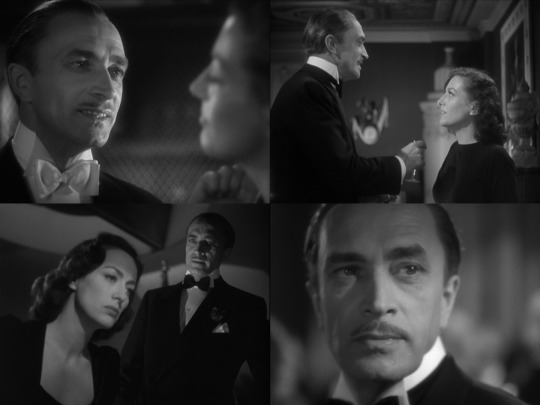
A Woman's Face Dir. George Cukor 1941
Torsten Barring.
That's it, that's the review.
It's taken me a minute to come back to this movie. There's no real reason except for me it's kind of like looking into the sun, something you shouldn't do often. But in my initial epic Veidt Watch, A Woman's Face was the point of no return. Up until this, I'd been watching a lot of Connie's silent film work, which I think you can see trace elements of in his performance here. If I was interested in his work as an actor before seeing A Woman's Face, afterward there was no way I could stop this train even if I wanted to.
The more I rewatch this movie though, the more I'm convinced that the story doesn't really work. If I was a producer in 1941 and this script came across my desk, I would probably throw it in the garbage or pass it along to a lesser studio. But it does work as a challenge for its actors, especially Joan Crawford. And it works because George Cukor clearly had a unique eye and sensibility that translate the weird, melodramatic plot into a relatively layered and complicated film.
I'm even more convinced that the story itself is eye-rollingly obnoxious because of how absurd the two radio play versions are. But in my heart I want to give these recordings a pass because they're basically pure camp in a way the film is not. There's so much nuance and subtlety in the film that could never be captured by a purely audio format like radio, no matter how accomplished and famous your lead actresses are (sorry, Bette Davis and Ida Lupino >.<).
I'd be interested to see the original 1938 version with Ingrid Bergman (on Internet Archive) to see how the Hollywood remake measures up. I'm curious if the Swedish version is also held together by its actors and director the way Cukor's film is.
From reading a few interviews with George Cukor, one gets the impression he didn't really hold this picture in very high regard. It sounds like they had fun making the movie, everyone got along pretty well, but it's not considered a high point in Cukor's filmography by him or by film critics. Which is interesting because the movie is not lazy, it's made extremely well and there are a lot of interesting, careful creative decisions that influence the impact the film has, at least on me. But I guess compared to his other films, of which I have seen embarrassingly few, A Woman's Face isn't considered as high brow or accessible because it's a little too out there for American cinema in the early '40s.
There's a soft gothic look and feel to the way the movie is shot. There are some clever moments with shadows that I really like that feel less like a nod to the graphic high contrast of German Expressionism and more simply about mystery and things that are hidden. It's a brilliant move hiding their lead actress until well into the film, and her eventual reveal, also expertly done without any crazy underscoring, is empathetic rather than shocking. There are a number of moments like that throughout the movie where the lack of an accompanying soundtrack or dialogue add to the tension, like in the scene where Anna and Lars Erik are in the sky car above the waterfall or her unbandaging post-surgery. Dramatic music or narration over these scenes would have cheapened them.
On this watch, a new thought occurred to me. Something about the visuals and themes make this movie feel like a dark and surreal fairytale. I think the fact that they kept the story set in Europe and didn't choose to relocate it adds to this feeling. This is definitely only a half baked idea, but hear me out. There are of course the themes of beauty and goodness, how they are or aren’t connected, but also belonging and love, and maybe most importantly thinking you want one thing at first and realizing you actually wanted something else the whole time. There is this idea of masks, whether it's Anna's scars or the "well-tailored person suit" Torsten wears (yes I am quoting Hannibal, yes it will happen again). There's something about the proximity to and power of nature -- the forest where the story properly begins, the snowy mountains and waterfall near the Barring estate. But the thing that sparked this idea initially was watching Anna arrive at Torsten's apartment for the first time. It's very much the fairytale heroine walking into the monster's castle. Anna has to enter and pass through two iron gates guarded by a crone (has to be intentional, right?, it could have been a doorman but they chose an old woman), then she has to go through the ordeal of facing her own reflection in a long hall of mirrors (so cruel, so messed up) before she reaches his door. Then there's Torsten's apartment itself. It's all gilded opulence, none of the furniture looks particularly comfortable, it's more like a museum than a home. And, maybe I'm wrong, but there aren't any windows?? And if there are, we don't get any sense of the outside world. He's created in his home a seemingly beautiful and well-curated cave or cage where he traps Anna behind closed doors and with his body language. I can’t stress enough how smart and intentional all these decisions feel.
The religious references maybe are a little obvious, but it's fun to throw around devil language about Torsten. And the allusions to saints, whether specific or general, in regards to Anna may be too on the nose, but she knows and the audience knows she's not saint-like, even at her best. The talk about God seems to center around Doctor Segert which really only makes sense because he's a surgeon and what do surgeons do if not play god?
The first time I watched this movie I was surprised by how subversive it felt. My impression of films made at this time was that they were all pretty conservative in order to pass the Hays Code. Of course I know now that wasn't always the case. Directors, actors, and writers were always doing increasingly creative and interesting things to circumvent the Hollywood censors. And A Woman's Face absolutely belongs to that class of surprisingly taboo films for this era. Anna and Torsten's relationship is clearly uhh not vanilla. There are pretty clear indications of sadism and dominance in how he handles and speaks to her, and in the way she reacts and responds to him. They're not exactly hiding it. And of course the only way they were able to get away with any of this was because Anna inexplicably winds up with the doctor in the end.
And on top of that it's a wonderfully queer movie made by a bunch of queer people. The assumptions of traditional American gender roles and expectations were thrown out the window. Anna doesn't neatly fit in any standard film archetype for a female character at the time. And having a queer coded villain wasn't exactly a new thing in filmmaking, but it suits this particular and allowed Connie more room to play with the character. And on top of George Cukor being gay, his two leads were bisexual according to multiple sources. There was no way this movie wasn't going to slay the house down boots.
The only thing about the movie that really bothers me is the casting of Dr Segert. I hate to say it because I feel like a lot of people really love Melvyn Douglas, but he was a weird choice for this film. I hadn't even seen him in anything else before I saw this movie, but something bothered me about him in the role. Now I know it's because they cast him against type, he usually played snarky or annoying or goofy characters. He can’t possibly match Connie and Joan, and I'm not asking him to. But it would have been nice if they had cast someone likeable, then maybe the end of the film would have made more sense. The only other cast member worth shouting out is Osa Massen as Vera Segert, I love her, she's too much.
I haven't seen a lot of Joan Crawford's movies, she had a long career with a lot of ups and downs, but I have seen Mildred Pierce, the film everyone cites as her best work as an actor. And I have to say she's better in A Woman's Face. Anna is a thousand times more interesting and complex a character than Mildred Pierce. I mean, if I had to choose between a bitter, lonely, outcast blackmailer and a tragic, betrayed, single mother, I would pick the hardened criminal every time. I think people point to Mildred Pierce as Joan's best film mainly because they haven't seen A Woman's Face, and maybe because Michael Curtiz gets more accolades as director because of Casablanca where as Cukor just made "women's pictures", I don't know. But Joan Crawford surprised me with this performance, I think it was the first time I saw her and thought, hell yeah, now that's an Actor.
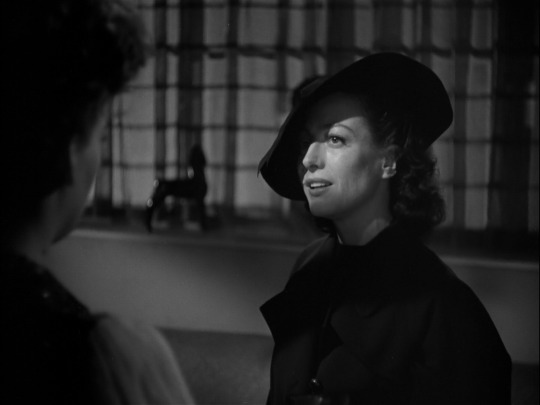
She builds up Anna's defenses so much that when she finally lets her guard down when one person finally really sees her and isn't afraid of or disgusted by her, it's like *chef's kiss* perfect. There's a realness to her vulnerability that simply couldn't be matched by other leading actresses at the time, and I think that has a lot to do with Cukor pushing her beyond her comfort zone. Apparently he made her do the scene where she describes her past and the accident that left her scarred over and over to get just the right amount of detachment, so she wasn't performing the story. But I also think she was pushed to deliver a really excellent performance by her primary costar; I don't know off hand any other instance where Joan had such an accomplished and grounded scene partner as Conrad Veidt. He's so anti-Hollywood in his style and approach that I have to believe some of his work ethic and energy influenced her and helped pull this amazing performance out of her.
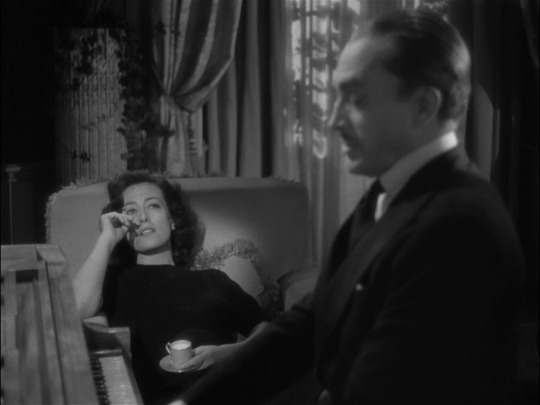
Anna is such a great character, she represents the monstrous female, something society tells us to fear. Because she's not just scarred on the outside, but her emotional scars made her self-sufficient and unyielding, traits unacceptable in a woman. People keep calling her heartless, but she had a heart the whole time; she's not a sociopath, she does everything she does because of her wounds, because her heart feels the pain of rejection and loneliness so deeply. Of course she has a heart, she falls in love with Lars Erik after, what, a week?? It's gut-wrenching to be treated and thought of as repulsive and ugly your whole life only to one day meet someone who doesn't look away and who treats you as though maybe you're not repulsive, not ugly, as though maybe you are desirable and worth wanting (and totally not relateable in any way lolololol). So when given the chance, of course she would take any opportunity, no matter how difficult or painful, to change herself if it meant acceptance or even desirability. Her whole concept of love evolves throughout the film, but there's a deep connection for her between love and sacrifice or total surrender. She sacrifices her autonomy and submits to the painful ordeal of intense cosmetic surgery in order to be loved by Torsten. She's willing to sacrifice her very life in order to protect Lars Erik. Anna's guilt and shame drive her to decide to commit suicide by the end, something I feel like is glossed over in the film. And it's even more tragic because she's established as this survivor character pretty early on. That's why the ending of the film is so unsatisfying.
It's funny, I recently also watched Now, Voyager and I can't help comparing the two films. Bette Davis's Charlotte in Now, Voyager is also shunned and mistreated because she's considered ugly, but the damage done to her wasn't an accident, it was intentional abuse. But both Charlotte and Anna were young victims of forces outside of their control that warped them into easy targets for male intervention. Charlotte's trauma made her neurotic and riddled with anxiety; Anna's made her brittle and vengeful. They both had two separate and very different men and someone else's child in their lives. But I prefer Charlotte's ending, her ultimate decision to devote her life to herself and her foster daughter. By the end of A Woman's Face on this rewatch, I was yelling at the screen, "Girl, you don't love that doctor!" She says want she wants: "I want to belong to the human race." And I believe she really cared for Lars Erik, so forcing a last minute love connection with Segert at the end of the film feels like nothing other than a band-aid to make the movie palatable to the censors and average American audiences. And Joan and Melvyn Douglas have like zero chemistry. It's so frustrating, Anna deserves better -- sure she's probably avoiding jail time because the judge will declare Torsten's murder as justifiable homicide, but UGH that doctor does not love her! The whole doctor/patient "I can fix you" thing is just as problematic as her relationship with Torsten to be perfectly honest.
And oh Torsten. That nasty, nasty man. You can just tell Connie had the time of his life getting to be "Lucifer in a tuxedo." And it's so, so good because he refused to make his villains one dimensional. On paper, Torsten is entirely ridiculous. But if a script did not provide enough backstory or motivation, Connie would go above and beyond to craft a whole inner world for these bad men in order to flesh them out. And Torsten is no exception.
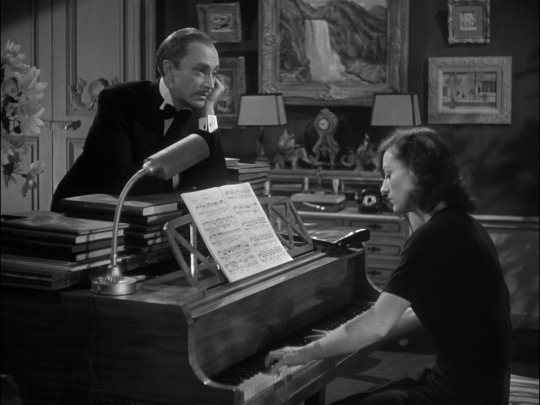
Torsten's evil is insidious. To continue to beat the fairytale comparison to death, Torsten is a big bad wolf if I ever saw one. He may not exactly be a wolf in sheep's clothing, but he does wear this "person suit" that continues to slip by degrees through the film so that by the end he can barely contain the slavering, glassy eyed monster underneath. There are moments even early on when you can see through his carefully crafted façade, one so much more nefarious than Anna's. The first time he really looks at her, you can see the wheels turning in his head almost immediately as spots his prey. He even bares his teeth to her, in a diabolical and disarming smile that I love so goddamn much. He knows early on he can use her but isn't sure how much to reveal, how much of himself to let her see. When she returns after her surgery, he greets her with charm tinged with mild annoyance. But when he sees her new face, the mask cracks open and he inspects her like an animal sniffing out a threat. He decides he can take advantage of her new confidence to bind her even closer to him, starting to play the weaving song on the piano, laying the groundwork for the next phase of his plan. When he makes it sound like she's the one suggesting they kill Lars Erik, a previously unseen intensity and fire creep into his eyes. His cruelty and malice are suddenly right under the surface but he doesn’t raise his voice or hand to her.
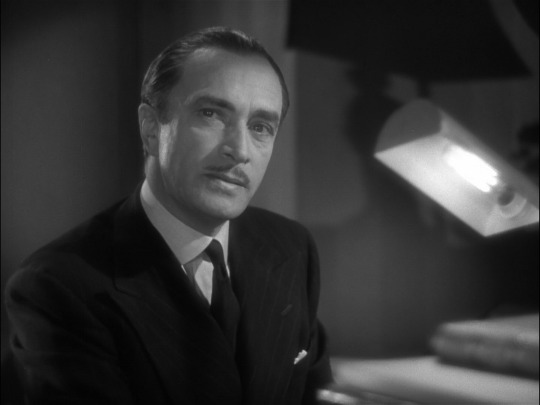
His whole demeanor and energy is such a wonderful contrast to what Joan is doing as Anna, that I wonder whether he made that decision during filming. I love that Connie chose to keep Torsten's voice silky even when he's being nasty. There's occasionally a slight change in his tone, becoming less seductive when he's actively annoyed. The only time he distinctly changes his vocals is during the attic scene when he finally shows his true face to Anna. That's the first time he raises his voice to her, but only when his back is turned. There are a lot of interesting things happening whenever Torsten turns his back -- when Anna reveals her true "vocation" as a blackmailer, he's facing away from her but we get to see the fraction of a second where he knows everything is falling into place, and that look disappears the instant he turns back to her. It's only then that he carefully and calculatedly reveals his own damaged nature to Anna, saying they're just alike, "both poor, both wretched." And I think he really believes it, too.
I do think in some twisted way Torsten does genuinely like Anna, but because he probably doesn't have a single close relationship that isn't some form of manipulation, he's incapable of truly caring for her. His own interests and desires are his only priority. Torsten's seemingly sudden 180 degree shift into power hungry psycho killer at the end does at first maybe come across as absurd and unrealistic, but as I see more and more men IRL turn out to be absolute fuckbags, I have to think maybe Torsten's not as much of a caricature as people assume. The reveal of his ambiguous plans for some kind of authoritarian power grab doesn’t feel as far fetched. The whole time, he plays Anna like a fiddle to get what he wants: money. And with money comes influence and power, not just to pay off his increasing debts, but money to control and subjugate others. He believes whole heartedly that he was cheated from the family fortune and that belief festered in his mind until it made him sick, sick for any kind of alternate future where he's the one doing the taking instead of being taken from. It's an all too common male power fantasy we still see over and over. The fact that we don't see this side of him right away feels unfortunately prescient.
Let's talk about the attic scene. It's the scene people talk about the most. It's Connie's moment to shine, his monologue is perfectly executed, it's just unhinged enough. Up until and including this point, you don't want to take Torsten seriously, but there are moments here when his eyes glaze over and he's almost literally panting when you realize this guy isn’t fucking around. His utter contempt and superiority and disgust at Anna's decision to be a decent person is a masterclass in classic cinema villainy. And again when he stalks away from her saying "the spirit of love has triumphed, yes; God is in his heaven, yes!", he pauses, turns back to her and reveals another layer, the core of his being. He's no longer charming playboy Torsten Barring, he's the fucking devil, cast out of heaven, steeped in his own bitter rage and resentment, contorted into a hungry, dangerous animal. It's interesting there aren't a lot of cuts in this scene, it's mostly a single shot and we don't get any direct closeups of Anna. She's always in the foreground, but the camera doesn't single her out, it keeps both of them in the shot, eventually pushing in to an uncomfortable closeup of him with his hand around her throat. And she barely speaks, and instead of fighting with him, she shuts down.

Am I the only one who wishes Anna and Torsten got to have more of a final moment together? While the chase scene is exciting, maybe they could have struggled at the waterfall's edge in a final showdown. Something face to face between them would have felt way more satisfying than her shooting him in the back from a distance.
How Connie doesn't have second billing for this film is beyond me. I love this role for him because it's such a departure from his other Hollywood villains in the '40s. He very nearly steals the film from The Joan Motherfucking Pepsi Cola Crawford. It's nearly impossible to take my eyes off him in this film (ok that's been true for all of his films, but with A Woman's Face it's even more of a problem). He looks incredible, his suits are impeccable, his voice is sensually sinister, what more could you want? He has this presence and hypnotic quality especially in this role that audiences ate the fuck up and wouldn't see again in another actor for decades. I'm telling you, there are only a very small handful of other actors who get typecast as villains who could do this kind of delicious dark magic on an audience.
This was the Conrad Veidt film that got me hooked. Torsten sunk his claws into my mind and hasn't let go yet. And as it's still Conrad Veidt's birthday when I'm writing this, I have to give him his flowers. This movie really should be more celebrated if only for the fact that Connie and Joan Crawford and George Cukor absolutely killed it.
Bonus: look how cute his gloves are!
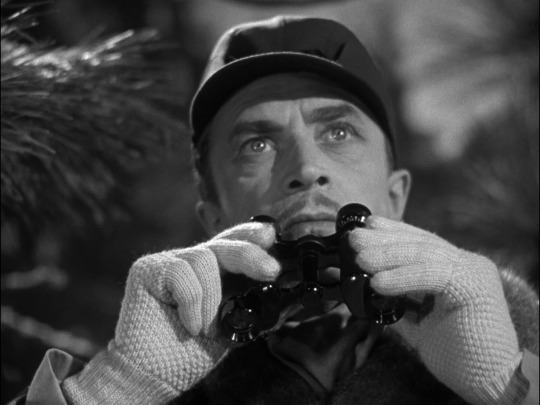
13 notes
·
View notes
Text
Needy Streamer Overload Spinoff Typing Of The Net Launches On Steam
(from Jan 20)
youtube
WSS Playground, developers of Needy Streamer Overload, have released a new spinoff title, Needy Streamer Overload: Typing of The Net. This typing game, centered on internet culture, is now available on PC via Steam for $7.99. The launch also introduces the “Internet Angel Pack” Digital Deluxe Edition, which bundles the original game, the spinoff, a 300-page digital artbook, and two soundtracks, including music from the new title. In case you missed it, check out our review.
A Typing Game with an Internet Focus
In Typing of The Net, players take on the role of a dedicated fan of OMGkawaiiAngel, a fictional content creator. The gameplay involves typing internet “slang” messages during livestreams to catch the streamer’s attention. With over 200 terms included, the game challenges players to stay in sync with online trends and quick-paced typing mechanics. Each term is explained mid-game, offering a brief exploration of internet culture while advancing the game’s fast-paced challenges. The game combines elements of nostalgia and modern online interactions for a distinct typing-focused experience.
What’s Included in the Digital Deluxe Edition
The “Internet Angel Pack” Digital Deluxe Edition provides additional content for fans of the series. It includes:
The original Needy Streamer Overload and Typing of The Net
A 300-page digital artbook featuring illustrations and concept art
Two complete soundtracks, including new music from the spinoff
Access to the Petit Game Collection Vol. 1, featuring mini-games from the series
This bundle is positioned as a way for fans to explore more of the series’ visuals, music, and gameplay.
Availability and Pricing
Needy Streamer Overload: Typing of The Net is now available on PC via Steam for $7.99. The game offers support for English, Simplified Chinese, and Japanese.
For more updates on this title and others, stay tuned to Noisy Pixel.
#Typing of The Net#Needy Streamer Overload: Typing of The Net#Needy Streamer Overload#Needy Girl Overdose#WSS playground#Noisy Pixel#Youtube
8 notes
·
View notes
Note
I’m a big Hamlet fan and I am curious as to what your favorite movie/for screen rendition is? I’ve been working my way through a lot of them, gone through about 7, so far Hamlet at Elsinore with Christopher Plummer is my favorite. I was just curious what yours is !
What a great question!!
Hamlet at Elsinore is definitely my favorite filmed version of the play. I feel that Christopher Plummer does a fantastic - and frankly critically underappreciated - job of portraying the more nuanced and complicated aspects of Hamlet's character while still giving a straightforward performance that's highly accessible to any audience. Notably, he doesn't treat the performance as his ~*~epic, defining role of a lifetime~*~ or ~high artistic theater~ (*cough* Branagh and Jacobi), but instead focuses on telling a deeply compelling, very moving story about the complex nature of grief and revenge. I also like that this version embraces the more "postmodern" elements that exist in the written text of Hamlet: the complicity of the audience, the inevitability of the outcome, Hamlet's genre-awareness and genre-defiance, etc.
[Not to keep hating on Branagh, but in contrast: Branagh's Hamlet in particular seems to go out of its way to avoid including the more interesting proto-postmodern thematic elements of the play - at times not seeming to recognize that they're even there. He instead focuses his time and energy on inserting new cinematography-based visual themes that go nowhere and at times stand in OPPOSITION to the actual tone and themes of the original text. Because apparently Hamlet the play is too boring and instead of lame elements like "themes" and "compelling characterization," we need a swinging chandelier sword fight scenes and Freudian weirdness. Truly the Joel Schumacher Phantom of the Opera adaptation of Shakespeare films. But I DIGRESS-)
Plus it doesn't hurt that everybody aside from Plummer in Hamlet at Elsinore is also fabulous. Obviously, Michael Caine's Horatio is the single best and most definitive version of the character in film, but I also love Robert Shaw's Claudius and Muller's Ophelia.
If we're talking favorite filmed versions of the STORY of Hamlet though, that's Asta Nielsen's silent film from 1921. It's so beautifully filmed and wonderfully told. She's what I picture when I picture Hamlet.
Other than that....I like Tennant and Stewarts' RSC filmed version well enough. It has a number of very strange choices and I don't love the re-ordering of the scenes, but Tennant does a great job with the character and I think it's a very approachable performance. A few other filmed stage versions are also excellent, though with a few similarly weird elements - I'd put Maxine Peake's version on the same tier as the RSC version. I do NOT like Branagh's version at all (if you couldn't already tell...). Jacobi's and Gibson's are slightly better, but they're still too focused on the prestige of the performance rather than the actual story being told imo. I think they fall under the same criticism as Holden Caulfield's scathing review of Laurence Olivier: "more like a general than a sad, screwed-up type guy." (Yes I know this line is an in-text authorial critique of Holden himself but also: he's right and he should say it.)
If you haven't already, I do highly recommend listening to the BBC Radio 4 audiodrama version of Hamlet, starring Jamie Parker. Despite being a audio version of a stage play, it somehow blows every filmed version of Hamlet (except maybe HAE) out of the water. I listen to it at least once a year.
Finally, my actual favorite versions of Hamlet have ALWAYS been those I've seen live (or seen bootleg filmed stage performances of lmao). If it's ever playing live near you, definitely go and see it. The play was meant to be seen on a live stage in front of you, and many of the jokes and themes only make sense in that context. In my opinion, the medium of live theater elevates the play so far beyond what a movie could ever achieve.
...sorry this answer is so long 😅 Really, it doesn't matter what my opinions on Hamlet films are. If any version of the play really speaks to you - even if it's the accursed Branagh version - that is so awesome and makes me really happy people are engaging with the play in that way! (But since you're saying that HAE is your favorite so far, I will add that you have excellent, discerning taste ;))
#hamlet#willy shakes#'not to keep hating on Branagh-' I say like it's not been the leitmotif of my blog for over a decade#I cannot help myself. any opportunity I am throwing down.#shut up e#shakespeare after dark#should we bring that tag back? I feel like we should bring that tag back
51 notes
·
View notes
Text
Apr 3, 2025
00:00:00 --> 00:10:00 – The hosts reminisce about the show’s evolution, from early image feeds to livestreams and changing co-hosts. Mike shares updates about working as a sound engineer for his wife's band and reflects on the challenges of music production. The show dives into Alex Jones clips, including bizarre rants and confusion between Jeff Goldblum and “Jeff Goldberg.”
00:10:00 --> 00:20:00 – More absurd Alex Jones quotes are played and analyzed, filled with shirtless rants and chaotic statements. The team introduces headlines, focusing on a new alien abduction thriller called Watch the Skies, and discuss its AI-generated dubbing and visual effects.
00:20:00 --> 00:30:00 – They continue analyzing Watch the Skies and its use of AI for dubbing and mouth animation. The discussion leads into re-edited trailers that change film genres (What About Bob, The Shining). Paranormal news headlines are teased, including a man arrested for collecting periodic table elements and Argentina releasing secret Nazi documents.
00:30:00 --> 00:40:00 – Focus shifts to a viral story about a Chinese woman living in a workplace toilet to save on rent. The hosts review images and videos of her setup and speculate about her living conditions. Mike plays a satirical rock ballad he wrote called “Living in a Chinese Toilet.”
00:40:00 --> 00:50:00 – The conversation returns to the Nazi documents released by Argentina. They discuss the possibility of Hitler having escaped to Argentina and its potential historical implications. Theories about U.S. intelligence knowing but covering it up are explored, along with links to post-war intelligence programs and Antarctica.
00:50:00 --> 01:00:00 – They explore absurd ideas about Hitler in retirement mode, drinking pina coladas in beachwear. Then a shift to food trends: the team mocks the marketing of protein-added foods like coffee and chips. They introduce the legend of “Little Foot,” a small Bigfoot-like creature spotted in Pennsylvania.
01:00:00 --> 01:10:00 – The legend of the “Albatwitch” (Little Foot) is explored further, including historical sightings, folklore, and a local festival. Researchers and authors discuss theories ranging from escaped primates to young Bigfoot. Quartz deposits and strange disappearances in the area are also touched on.
01:10:00 --> 01:20:00 – Mike shares a personal family story resembling a missing 411 case, where his grandfather disappeared mysteriously in Pennsylvania. Listeners call in, discussing cryptid sightings and humanoid encounters, including creatures crawling from drains and explosions with no explanation.
01:20:00 --> 01:30:00 – A caller talks about vacationing in Argentina and visiting German-influenced towns possibly tied to post-WWII Nazi escapees. They describe tourist-friendly areas, statues, and being asked for papers in an eerily “authentic” way. The discussion drifts into absurdity about Hitler disguises and statues with rubbed-down anatomy.
01:30:00 --> 01:40:00 – More listener calls cover cryptids possibly being ancient genetic experiments. Topics include dogmen, fallen angels, and Nephilim. There's discussion about a theory where dogmen are creations of hybridization or supernatural tinkering, and how various cryptids may have originated from biblical or mythological events.
01:40:00 --> 01:50:00 – A news story about Florida ranking among the best states to survive an alien invasion is covered and mocked. The group critiques the bizarre criteria used, including caves and healthcare access, and compares state rankings. They explore the absurdity of a website called "Gigacalculator" being the authority on alien readiness.
01:50:00 --> 02:00:00 – Ohio ranks #19 in alien invasion survival, while states like Nevada and Arizona are at the bottom. They joke about calculating alien defense readiness with giggle-based math. Another local story is covered about a Portland man repeatedly finding gallons of urine in his recycling bin. Speculation includes tiger urine sales and the return of the woman living in the toilet exporting her waste.
4 notes
·
View notes
Text
Hybrid Class Review: Skald part 2

Utility and Builds
(art by Scieth-A on DeviantArt)
So let’s get into the grit of what the skald has to offer.
As a much more martial class, skalds enjoy being able to wear medium armor and shields without spell penalty and have access to martial weapons without feats. Additionally, they start out knowing how to scribe scrolls, tapping into their role as saga-keepers.
Additionally, they draw their spells from the bard spell list, which we know from experience focuses on buffs with a minor in debuff with some utility and unique attack spells, especially those that deal sonic damage. The even cast their magic spontaneously as bards tend to do.
They also gain a big bonus to all knowledge skills and can tackle them untrained.
Skalds also gain their own, more warlike version of bardic performance, which counts as such for the purposes of feats. However, the raging song is audible only (which I find a bummer). They can learn any bardic masterpieces as well through the usual method, as well as special ones limited to the skald class called sagas.
The first raging song: inspired rage, is where the bard and barbarian classes come together, as the buffs provided are very similar to the bonuses provided by a barbarian’s rage, as well as the penalties and hindrances. Luckily, one does not have to accept the bonus if they would prefer to cast spells and avoid direct combat. What’s more, barbarians, bloodragers, and any other class or archetype that uses rage can choose to use their own rage bonuses when benefiting from this song, though they must spend their own rounds of rage to utilize any abilities beyond the bonuses.
The next song of marching sets the pace of a march, speeding up overland travel and reducing the fatigue it causes.
Another imbues the listeners with the might to perform various non-combat feats of strength.
When weakening foes is preferable to bolstering allies, skalds can invoke the dirge of doom to put foes on edge and weaken their resolve.
Finally, they gain a performance to wake the dead, getting dead allies back on their feet to keep fighting, albeit in a short capacity for a little while. However, this performance costs a lot of energy to do, making it hard to maintain.
Much like bards, skalds are able to utilize various performance skills in place of others where appropriate, tapping into what that sort of performance is meant to evoke. However, the list of types of performance is somewhat smaller since they only work with audible performances, rather than those with a visual element. Additionally, like bards they can tap into the alternate system of advanced versatile performances if they simply don’t want to put points into multiple performance skills.
Like bards, skalds are also well-versed enough to be quite resistant to audible effects, be they enchantments or sonic attacks.
And here’s where things get interesting: skalds gain several rage powers throughout their careers, and can apply them not just to themselves but to any ally that accepts the bonuses whenever they use inspired rage, though obviously they are still limited by totems and death curses, not to mention daily uses of certain powers.
They also get some of the instincts of barbarians to better perceive surprise attacks. This of course improves later on.
An ability wholly unique to this class, however, is the skald’s spell kenning, which represents vast mystical and occult knowledge that isn’t part of their regular spellcasting, but they can tap into to cast a few spells per day drawn from other magical traditions, the upper limits of said spells only growing as their own ability does. This makes them able to occasionally pull the perfect spell for a situation out of their proverbial wazoo, something I have personally experienced in the games I’ve run.
Like bards, skalds of a certain level of mastery know a lot about specific subjects, effectively letting them automatically ace a few knowledge checks per day, useful for learning about rare artifacts, powerful monsters, and the like.
Like barbarians, they also gain a measure of resilience against damage. Unlike a barbarian, however, they can share it with their allies as part of their inspiring performance.
Finally, the most powerful skalds perfect their performance to that their allies can gain the benefits of rage without restriction on what skills or abilities they use, and letting similarly rage-focused allies to use their own abilities freely as well. Finally, they inspire their allies to attack with more vigor, squeezing an extra attack out when they do nothing but attack in a round.
However, with the advent of Chronicle of Legends, we saw the rise of some alternate capstones. The one specific to the skald allows them to draw upon spell kenning lore much more often, and even expands that lore to include one more spell list beyond those normally available.
Beyond that, they also have more generic options, including the vast magical knowledge of Deep Magics, or Perfect Body, Flawless Mind to become as physically or mentally impressive as the greatest legendary heroes, becoming the leader of their own warrior clan or perhaps skald school with The Boss, transforming a trusted weapon or armor into a truly legendary implement with the blessing of With This Sword, or becoming an undying legend with Won’t Stay Dead.
The Skald offers a fun take on bardic buffing by making a class that forgoes a more subtle fighting style to stand alongside fellow warriors and hit hard with them. In a party with a lot of martial or semi-martial characters, they can be a godsend, though somewhat annoying if the party has their own mixed caster/combatants. Even still, the fact that their inspired rage only gets better by letting you throw in rage powers makes it much more powerful than inspire courage and other combat bardic performances despite the drawbacks.
Beyond their combat capabilities, skalds offer many of the same knowledge utility as their bardic counterparts, as well as the versatile spell kenning, which I’ve personally seen answer utility spell questions the party wasn’t prepared for, as well as important debuffs that turned a resource-draining slog of a fight into a more fun experience (fighting multiple ghosts with no ghost touch weapons or force spells can be a pain, but mass ghostbane dirge was the perfect answer)
Of course, don’t forget that this class, despite the ability names and presented aesthetic, this class need not be associated with viking cultures at all. Any culture that has members of the barbarian class, as well as those with deep histories involving mighty warriors might have characters that not only memorize such oral traditions, but seek to add the them as mighty warriors in their own right!
Consider how different rage powers work together, and how those would work if half the party also had them, and you can see what fun you can have with this class.
That’s enough for today, but tomorrow we’ll look into how archetypes vary things up!
8 notes
·
View notes